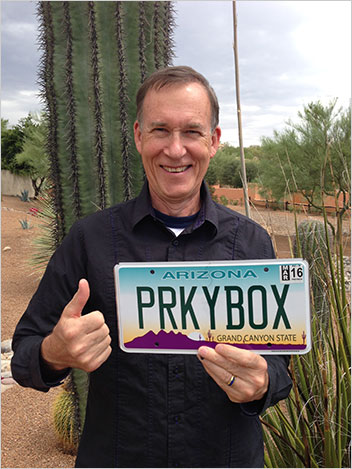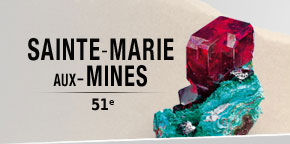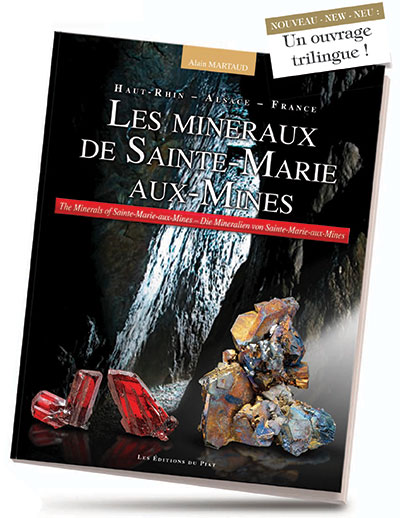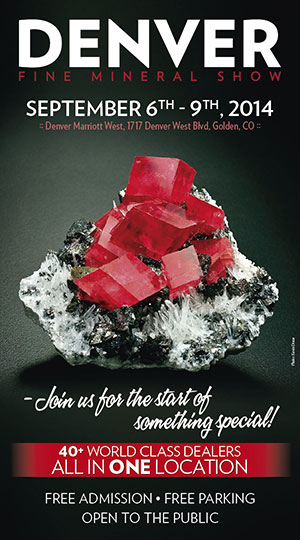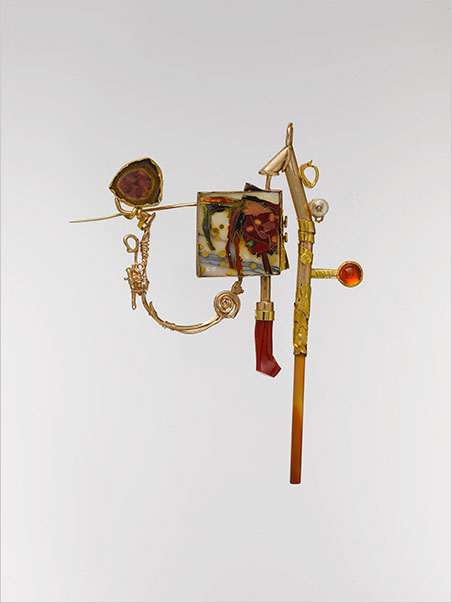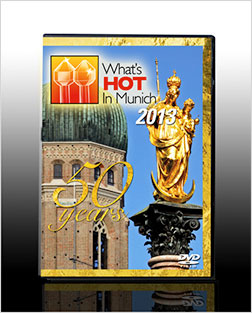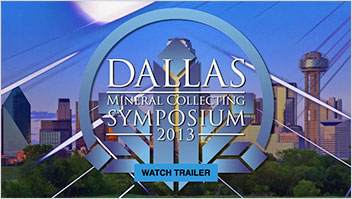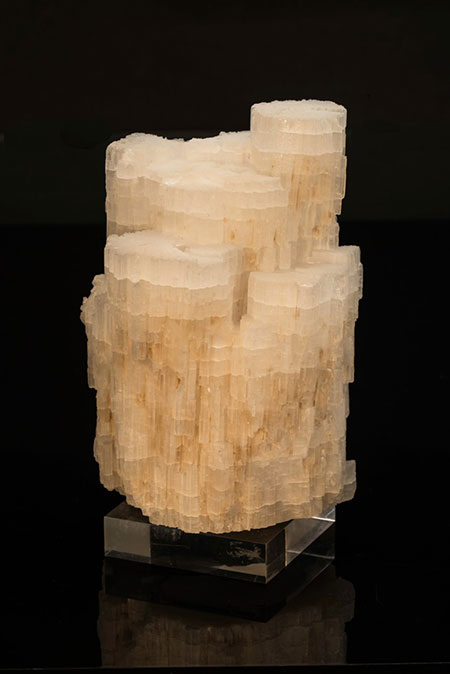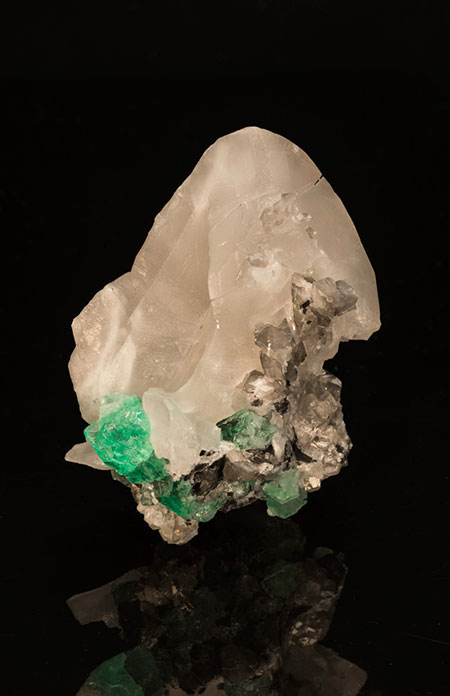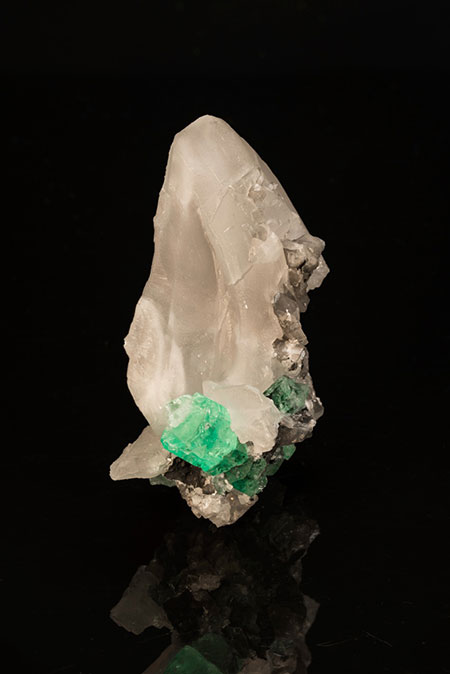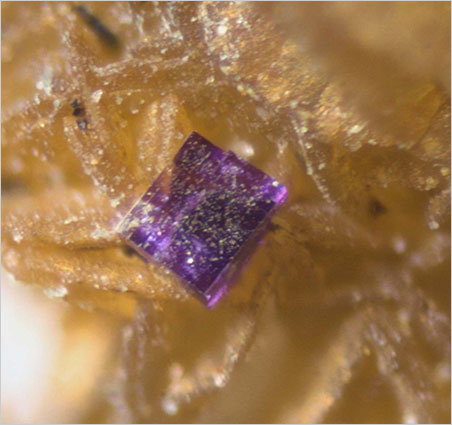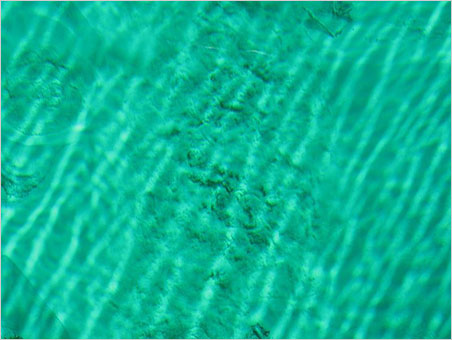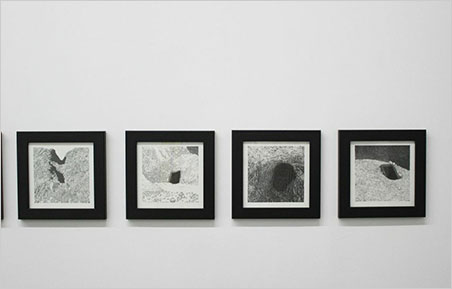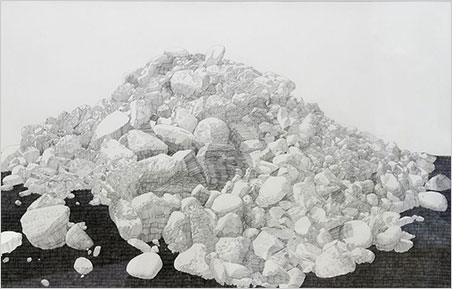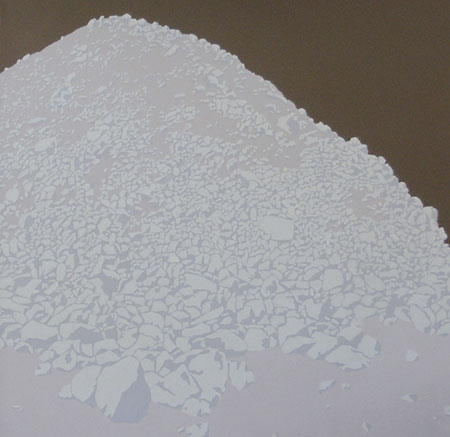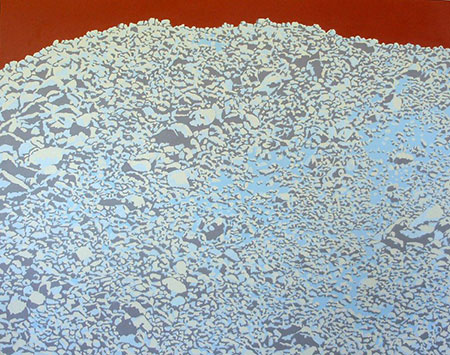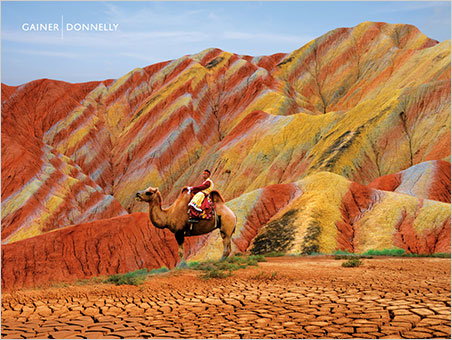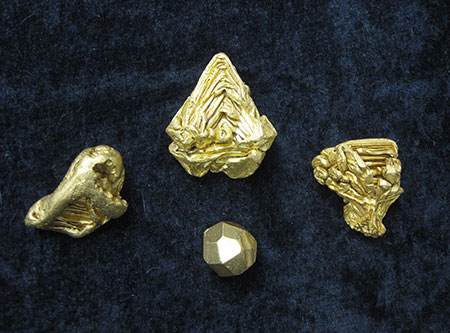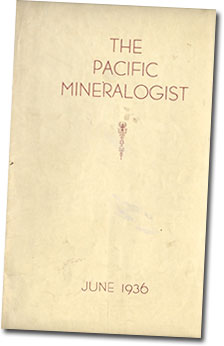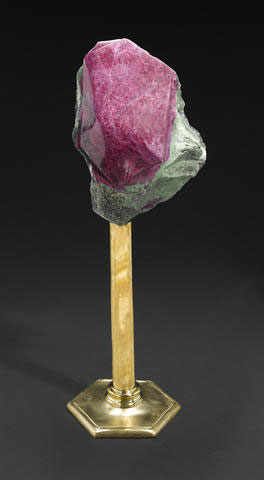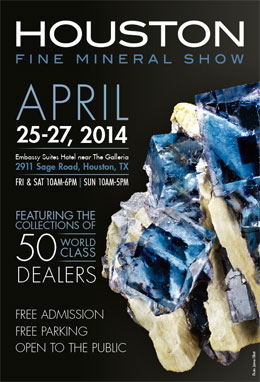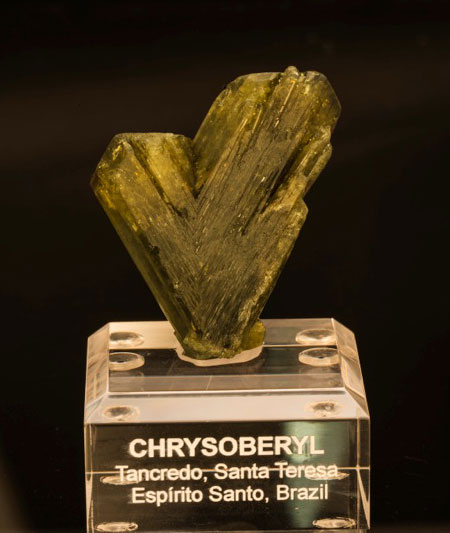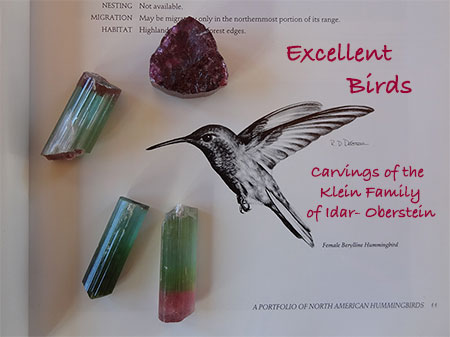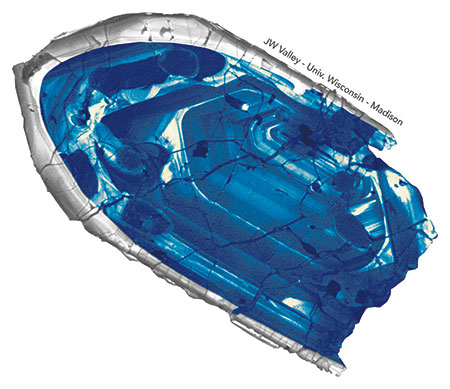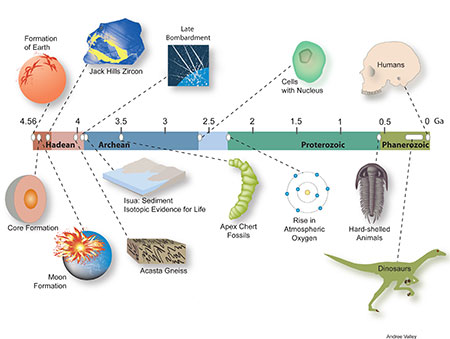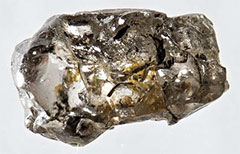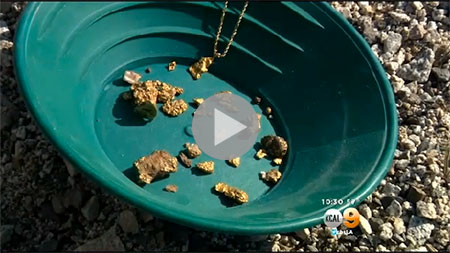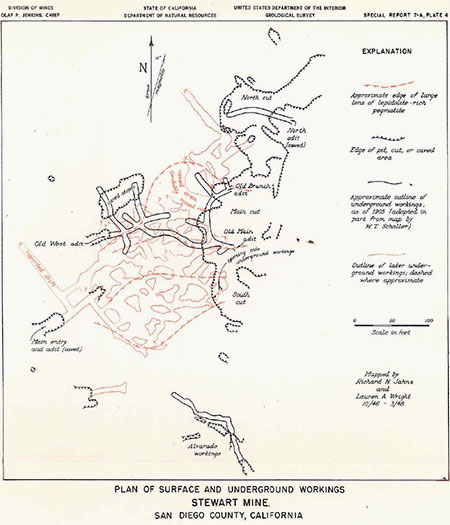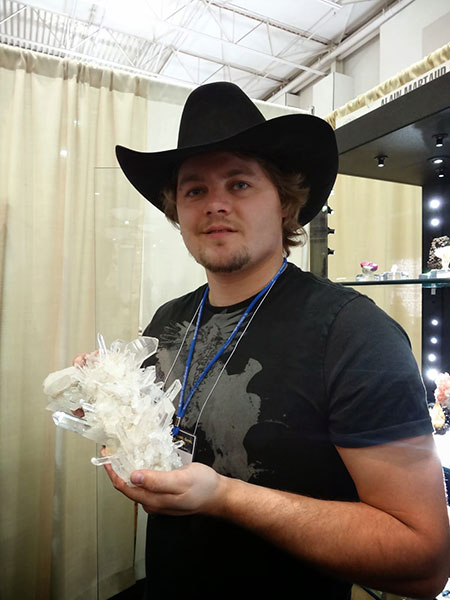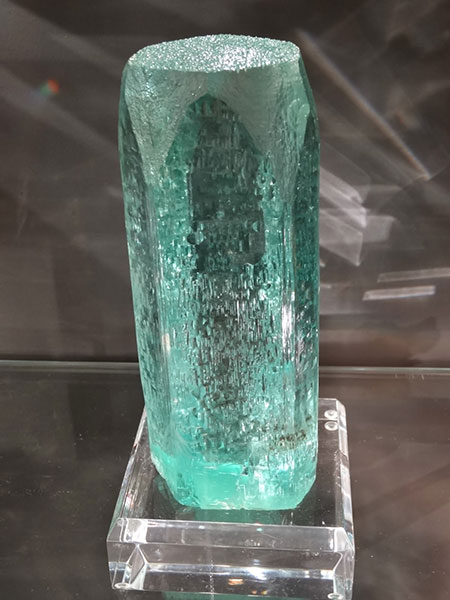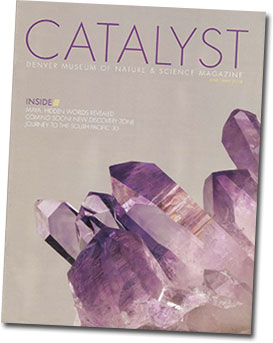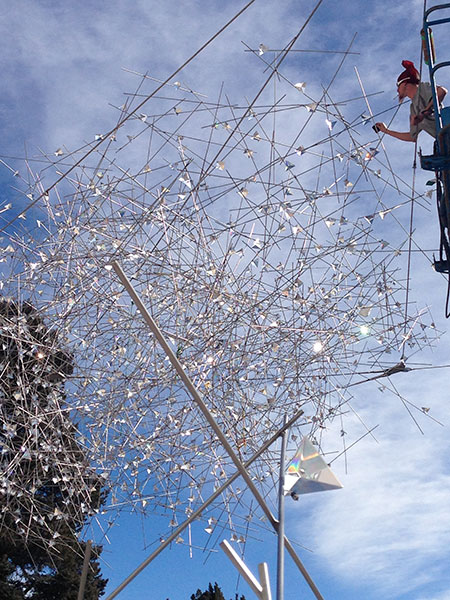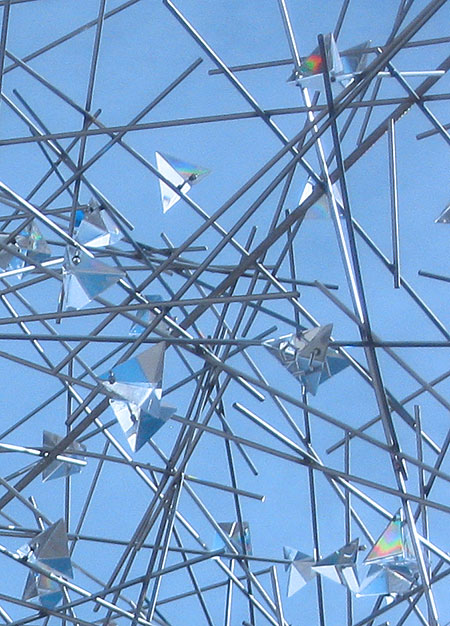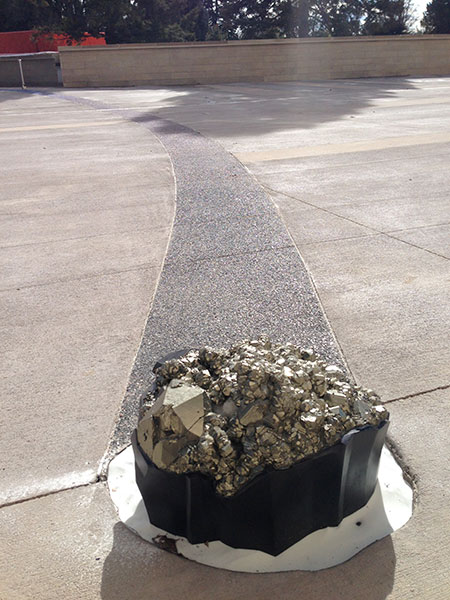
2015.2 | 2015.1 | 2014.2 | 2014.1
2013.2 | 2013.1 | 2012.2 | 2012.1 | 2011.2 | 2011.1 | 2010.2 | 2010.1
2009.2 | 2009.1 | 2008.2 | 2008.1 | 2007.2 | 2007.1 | 2006
February–June 2014 (published bimonthly)
- June Newsletter – June 3
- April Newsletter – April 1
- February Newsletter – February 3
June 2014 Newsletter
|
Shows and Events
Pala International NewsMinerals and Mineralogy News
Pala Presents
Recycle Bin |
Shows and EventsMineral & Gem à Sainte-Marie-aux-Mines: June 26–29, 2014
The 51st Sainte-Marie show will be held June 26–29, with the first two days limited to trade only. This year, Bill, Will, and Carl Larson will attend the show along with friend and fellow gem dealer Mark Kaufman. The show's website has had a makeover. Details in English are still forthcoming for the 51st Sainte-Marie show in June, but we thought we'd point to our friend Alain Martaud's limited-edition book, The Minerals of Sainte-Marie-aux-Mines. Alain discovered the Sainte-Marie mining district at age 14 and over the years has built strong relationships with collectors and museums, allowing the reader to access to a treasure trove of specimens and more. The 208-page book, signed by the author, contains 356 photos of the minerals found in Sainte-Marie's Val d'Argent in the last millennium. The book also includes illustrations, maps and historic documents. The text is trilingual: French, English and German.
The book is available from the show's online store. [back to top] |
Pala at Denver Fine Mineral Show: September 6–9, 2014Pala International will exhibit at the inaugural Denver Fine Mineral Show in nearby Golden.
We look forward to seeing our many friends there.
Visit the Pala International Show Schedule for future events. [back to top] |
Breathing Life Into the Inanimate: Artists Inspiring ArtistsOnce upon a time in the dark days of the 1990s, when AIDS became the number-one cause of death of men 25–44, your editor was given a cross-like construction by Los Angeles artist John Schroeder—with a story behind it. Schroeder was landlord to a man we'll call G, who had the disease well before the advent of life-prolonging drugs. A challenge like AIDS can bring out the best in people, but G was not one of those. As his condition deteriorated, he became meaner and meaner. It brought out the best in John, however. Undaunted, he would visit G in the hospital, the staff figuring the two surely were life partners, since who else would put up with G's rotten attitude? G died, of course, and some time later I was given the cross. "This piece (which John calls Pathos) was inspired or given to John by his experience with G," wrote the giver, John's sister-in-law. "I hoped you would appreciate its strangely religious beauty." Strange and beautiful it was, too, when I was told the cross was assembled from wood and cloth lifted from G's bedside. Thus artists take inspiration where they find it. And sometimes they are roused by other artists. Such was the case twenty years ago when artist and jeweler William Harper created his "Homage to Cy Twombly and Joseph Cornell," pictured below, a tribute to artists from earlier generations. We don't often include examples of jewelry in this newsletter (leaving that to our sibling publication), but I couldn't resist Harper's use of tourmaline, agate and coral. For instance, the translucent tube of solid agate at lower right; it really makes the piece. The brooch currently is on view in the Metropolitan Museum of Art's Unique by Design: Contemporary Jewelry in the Donna Schneier Collection, which runs through August 31, 2014. And we should mention here that the Met announced last month that 400,000 images are accessible by the public. See results returned for William Harper, Cy Twombly and Joseph Cornell.
Much of the sculpture by Cy Twombly (1928–2011) employed spindly pods on stems, cloth-wrapped dowels, propped-up flagless poles, all often dribbly gessoed. ("White paint is my marble," as he is quoted in Schmidt.) The technique is known as assemblage: taking found, unrelated objects and giving them a new (still) life. (But these are not the readymades of Marcel Duchamp nor the constructivist constructs of Vladimir Tatlin, although there is some cross-fertilization.) The assemblages of Joseph Cornell (1903–1972) are less monochromatic than Twombly's: repurposed boxes that become rooms, theater stages and backdrops, three dimensional paintings; like static frames of the Brothers Quay stop-action animation. Monographs on these artists are filled with examples of what stirred their hearts. Witness Cornell's titles: Story Without a Name—for Max Ernst; La Croisée, the Casement Window: Vermeer's Secret; Duchamp; For Paul Dukas "Symphony in C"; A Keepsake for John Donne; Mica Magritte II: Time Transfixed; A Parrot for Juan Gris; Variant Version for the Mahler Mäed.C.hen #2 (Symphony #3). Cornell's work, in turn, incited author Jonathan Safran Forr to "curate" a collection of fiction and prose written by twenty writers who were inspired by Cornell. As for Twombly, he shared the studio of allied artist Robert Rauschenberg—readymade motivation. And Katharina Schmidt's bilingual Cy Twombly: Die Skulptur / The Sculpture is littered with the sculptor's muses, visual and otherwise. "Twombly's love of the other arts, especially poetry," she writes, "led him to choose themes and motifs that—having originated as word-pictures—lent themselves to translation into his own medium." Twombly literally incorporated the words of poets like Rainer Maria Rilke and Constantine Cavafy into his work. With William Harper's "Homage" to the two artists, I was tempted to say that he combines Twombly's freeform spindles with Cornell's enclosures. You see, as noted in the caption above, this brooch comes with its own case, in the form of a book. I asked Harper about it, to which he replied, leading with a listing of his other sources of inspiration.
The Met declined to include container forms in this show, Harper told me, so as not to distract from the exhibition's focus. We're all eyes.
References
[back to top] |
What's Hot?What's Hot in Munich 2013
Last fall, the Munich Show celebrated its golden jubilee—fifty years of presenting a world-class exhibition of minerals. It was appropriate to feature gold, of course. As BlueCap Productions put it, regarding their documentation of the event, "For three days in October, probably the finest collection of gold specimens ever assembled in history was on public display to astound the over 40,000 visitors." BlueCap's What's Hot In Munich 2013 is now available via DVD or HD download. Your show hosts are Dr. Peter Lyckberg and Bryan Swoboda. Dallas Mineral Collecting Symposium 2013Also now available is the downloadable Dallas Mineral Collecting Symposium 2013. The viewer has the option of purchasing the entire 354-minute version or individual presentations.
Friends of Pala International get a 10% discount on any BlueCap order. Just enter the code palaintl when you’re asked for it while ordering. Dallas Mineral Collecting Symposium 2014 – August 23
The 2014 Symposium, to be held at Southern Methodist University, features the following lineup of presenters:
Details and registration are available at the Symposium website. [back to top] |
Pala International NewsPala's Featured SpecimensWith this edition of our newsletter we feature two specimens from opposite ends of the earth.
We lead off with a great rarity—a large, double-terminated, very complex beryllonite from Paprok, Nuristan Province, Afghanistan. This is a specimen for an advanced collector or museum.
We call our second featured specimen "The Emerald Sail Ship," with its concave calcite catching the ocean's air. This is an aesthetic, large calcite crystal with no damage and a lively green emerald crystal attached at the bottom. The emerald has a fine, etched termination that adds to its beauty. The sail hails from the locality of La Pita Mine in La Pita, Mun. de Maripí, Vasquez-Yacopí Mining District, Boyacá Department, Colombia. Interested? Contact us to inquire. [back to top] |
Minerals and Mineralogy NewsPretty, Puny PutnisiteThe February 2014 edition of Mineralogical Magazine (78:1, 131–144; abstract) announced the identification of a new mineral from the Polar Bear peninsula, Southern Lake Cowan, Western Australia. The material is called putnisite, named after mineralogists Andrew and Christine Putnis, University of Münster, "for their outstanding contributions to mineralogy, especially phase transformations in minerals and mineral surface science (mainly crystal growth and dissolution processes)" per Mindat. When Andrew first was told about the naming, he asked, "Can I make a ring out of it?" according to PRI. The answer is No; the mineral occurs in tiny, .5-mm-sized pseudocubic crystals. It also is too soft, with a Mohs hardness of 1½ to 2. But it is quite lovely, as the image below attests.
As reported by LiveScience, the mineral was discovered by miners prospecting for nickel and gold who saw bright pink specks. Samples first were sent to the Commonwealth Scientific and Industrial Research Organization (CSIRO), and then to Peter Elliott, a research associate with the South Australian Museum, coauthor of the above-referenced article. [back to top] |
Emerald Pool a Hidden GemAbout a week ago, NASA's Earth Science Picture of the Day featured a writeup and images of Michigan's largest natural freshwater spring, Kitch-iti-kipi ("big cold water," according to Hunt's Guide). Through snow-white sand flow 10,000 gallons a minute of water with remarkable clarity, having been filtered along the way through fissures in limestone. The water maintains a temperature of 45° year-round. Mineral-coated tree trunks and fish can be seen from a self-operated observation raft. Legends regarding the spring are recounted at the Michigan Department of Natural Resources, but caveat lector.
The spring hasn't always offered pristine scenery. It had been a logger's dump, with vegetation growing over the piles of trash. Dime store owner John Bellaire saw through the debris and convinced the spot's owner, the Palm Book Land Company, to sell the spring and 90 acres surrounding it to the State of Michigan for $10 in 1926. The State eventually acquired another couple of hundred acres. [back to top] |
This Silence Is Golden: Mining Nina ElderWhen your editor travels to Taos, New Mexico, I try to catch what's up at The Harwood Museum of Art, one of several operated by the University of New Mexico. Just before it closed on May 4, I caught "Art for a Silent Planet: Blaustein, Elder and Long," an exhibition by a trio of northern New Mexico artists. The motive behind the show was to expose this lesser-known threesome to visitors, like me, who would want to take in the work of big-name (and Taos denizen) Ken Price, recently departed, who was represented in a retrospective called, "Slow and Steady Wins the Race, Works on Paper 1962–2010." As Jina Brenneman, The Harwood's curator of collections and exhibitions writes, Blaustein, Elder and Long are part of a trend—and a lasting one, we hope—participating in visual conversations about our planet and regional landscapes. "And these artists," Brenneman writes, "all visually submit a silent, objective, and dispassionate plea for environmental introspection." In the show, Jonathan Blaustein's work was bold and smirky, just that side of silent. His "People Feed This to Their Children" was an image of a blue rock-candy crystal swizzle stick, the kind we've all seen but can't imagine ingesting. Debbie Long's "Tow Package/Yellow" was a confessional-sized cave studded with backlit stalactitic cast-glass objects from an auto boneyard—CB radio parts, hood ornaments and car parts—all brought into the "natural" world by Long's siliceous alchemy. But what really grabbed me were the panels of Nina Elder. Here the silence was complete, deafening, as the saying goes, but not from lack of response.
Elder tells me she works as a painter, drawer, construction worker, farmer and arts administrator—whew!—who grew up in the Rockies of Colorado and New Mexico. Her playgrounds—and landscapes—were mines, gravel pits and lumber mills. "Through paintings, drawings, and actions," Nina says, she "endeavors to illuminate that the contemporary landscape is the physical manifestation of modern needs, economies, policies, and powers."
"Mining is seen by some as an environmental disaster," she says, "yet it is inextricably linked to our ability to sustain contemporary life." Like musician and artist John Cage, Elder dares to find the sound in silence, the womb in the tomb of the abandoned shaft. "A pile of rocks might seem vague, innocuous, and mundane, or it might seem like a relic of some disaster," she says, causing the viewer to ask, "What kind of explosion caused this rubble? Why is there a hole in the ground?" The reply: "The piles of rock that I depict in this series of paintings and drawings are neither innocent nor the result of catastrophe. They are the result of mining, one of the most overlooked, yet literally earth shattering, human activities."
Like Cage's sonatas for prepared piano, which rendered some quivering strings nearly mute, Elder's topographies are ineluctably altered. As Leonard Cohen has sung, "There is a crack in everything/ That's how the light gets in"; there is room for musing. Says Elder, "My work poses these questions about the resiliency of a natural environment barraged with industrial voracity."
[back to top] |
eARTh: World WondersAs anyone knows who's spent time on social media sites, there's an awful lot to divert the attention from the 9-to-5. Disctractify.com wears this on its virtual sleeve, and we were happy to be sidetracked recently with a collection of fifty items demonstrating the varieties of earthly experience.
[back to top] |
Separating the Crystals from the NuggetsIn April, scientists at Los Alamos National Laboratory verified the world's largest single crystal of gold. Four samples came to the lab via John Rakovan, professor of geology at Oxford, Ohio's Miami University. (He also is an executive editor of Rocks & Minerals.) Because of their size, it was uncertain that they were single crystals. According to a University of Miami story posted on February 13, the samples were collected in placer deposits between the mesas (tepuis) of La Gran Sabana and the Roraima Shield District of southeastern Venezuela. The unnamed owner lived in Venezuela for thirty years during which time he and his business partner dealt in diamonds and gold from the region. The four being studied are the cream of the crop, and were offered at auction in 2006. But there were questions as to the authenticity of the trapezohedral sample; if it was a single crystal, it would be the world's largest trapezohedral single crystal in the world. When the samples were given to Professor Rakovan, he studied the trapezohedral sample using X-ray diffraction. The results were mixed: all faces except one demonstrated polycrystallinity. It was time to dig deeper, using another noninvasive technique—neutron diffractometry—which can penetrate one to two centimeters into gold (versus X-ray, which peters out at a few hundredths of a millimeter). So he approached Los Alamos.
Rakovan was excited about the, mm, prospect of the study at Los Alamos—as reported by the lab on April 7—because investigating the atomic arrangement of gold crystals this size hadn't been done before. By the time of the February 13 story, Rakovan and his Los Alamos colleagues had determined that three of the samples pictured above were indeed single crystals. With the April 7 story, came two notable announcements. First, the trapezohedral sample was determined to be polycrystalline. Second, the largest of the true single-crystal golds, at 217.78 grams, happens to be the largest such crystal in the world. For those scientifically minded, the April 7 report has a description of the technology employed as well as a brief streaming video that takes you into the lab. In the video, New Mexico State University physics professor Heinrich Nakotte states that the gold in the largest crystal has a market value of about $10,000, but a single crystal could increase that by "a factor of 100 or more." [back to top] |
Pala PresentsNotes on the Lithium Pegmatites of Pala, CaliforniaAn article by Maurice DonnellyWith Pala Presents, we offer selections from the library of Pala International’s Bill Larson, who will share with us some of the wealth of information in the realm of minerals and mineralogy.
In June 1936, a year after he'd received his PhD from Caltech, Maurice Donnelly contributed "Notes on the Lithium Pegmatites of Pala, California" to The Pacific Mineralogist. He had received his EM degree from the Colorado School of Mines and his MS also from Caltech, writing his thesis on the geology and mineral deposits of the Julian region of San Diego, which was published by the State of California in 1935. By 1945, Donnelly worked in the Soil Conservation Service in Riverside. At the 1935 commencement, Richard Chase Tolman gave the address. Tolman is commemorated each year when the Southern California Section of the American Chemical Society issues its Tolman Medal in recognition of outstanding contributions to chemistry. It was Tolman who introduced the young Linus Pauling to quantum theory. Donnelly apparently was a fan of Pauling's, in August 1960 writing him, congratulating him on "fighting battles," likely in reference to Pauling's peace activism, his being denied a passport in the early 1950s, and his publicity regarding radioactive fallout. Donnelly's 1936 article is yet another pre-war take on the Pala district. He takes the reader through the geography, history, geology, pegmatitic structure, and then mineral by mineral. [back to top] |
Recycle BinBelow is a recent item from our sibling publication, Palagems Reflective Index, that will be of interest to mineral enthusiasts. Bonhams Offers Largest Ruby CrystalOn May 20, Bonhams Los Angeles featured the largest ruby crystal ever to be offered at auction. It hails from the Longido Mine, Arusha, Tanzania. It weighs 100.53 lbs (228,000 ct) and measures 16 x 12 x 11 in.
The Bonhams lot details recount the story of the Longido claim by Tom Blevins and the purchase of another large crystal from Blevins by Ed Swoboda. This is the same story Ed provided us with before his death. See "Longido Ruby" on Palagems.com. The above-pictured ruby is seven times larger than the one Ed obtained. The crystal did not sell, but a museum-quality carving of a fan-tail falcon, from multi-colored tourmaline, did sell. According to the lot details, the figure was carved from a single piece of Brazilian tourmaline. It is the largest falcon that carver Manfred Wild of Idar-Oberstein, Germany, ever has carved. [back to top] — End June Newsletter • Published 6/3/14 — |
April 2014 Newsletter
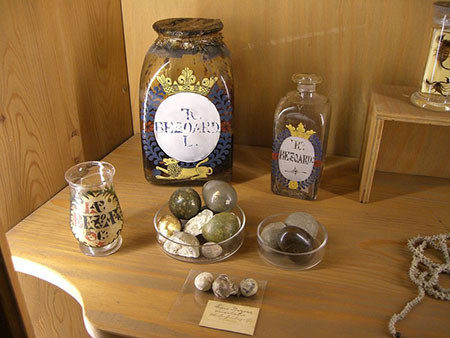 |
| From road kill, life. Jared Buzzell, of Lisbon Maine, witnessed a porcupine being hit by a car while he (Buzzell) was mushroom hunting Thursday. Remembering that his uncle had taught him the animal might contain a valuable bezoar stone (no, not a tourmaline), he cut open its stomach only to find instead a baby porcupine ready to pop. Massaging it, the tiny tyke began to breathe and is being cared for by him prior to being given to animal rescue. (See video here.) Above, bezoar stones on display in the German Pharmacy Museum in Heidelberg Castle. For centuries the stones have been thought to have curative properties. (Photo: Gerhard Eisner) |
Shows and Events
Pala International NewsMinerals and Mineralogy NewsIndustry NewsPala PresentsRecycle Bin |
Shows and EventsTwelfth Annual Sinkankas Symposium – Peridot and Uncommon Green-colored Gem MineralsApril 5, 2014, GIA World Headquarters and
|
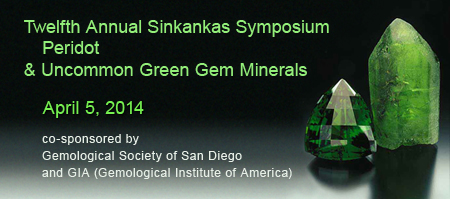 |
This year’s theme focuses on peridot and green-colored gems that have lower public recognition than their more illustrious counterparts such as emerald, jade, etc. For instance, Pala International’s Bill Larson will offer “Green with Envy,” a photographic odyssey of fine crystals and cut gems from worldwide localities featuring peridot and a panoply of uncommon green gems of beguiling beauty ranging from A (actinolite) to Z (zircon). Lisbet Thoresen, whose study of ancient garnet we reviewed in January, will discuss the disappearing act of the “poor man’s emerald” in her presentation, “Chromian Chalcedony: A Gem from History’s Lost and Found.”
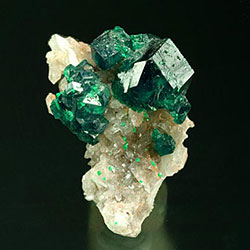 |
| This dioptase on gray calcite is a quite affordable thumbnail. From Tsumeb, Namibia. It features a sprinkling of bright green crystals beneath the lustrous larger crystals. Inv. #19477. (Photo: John McLean) |
Note that the speaker lineup has changed. Visit the Sinkankas Symposium website for speaker bios and abstracts of presentation topics.
- Lisbet Thoresen (for Dr. James A. Harrell), keynote speaker – Discovery of the Red Sea Source of Topazos (Ancient Gem Peridot) on Zabargad Island, Egypt
- Dr. Skip Simmons – Mineralogy and Crystallography of Peridot
- Dr. James Shigley – Olivine Geology
- Dr. Raquel Alonso-Perez – How Green Was My Sapat Valley: Peridot of Pakistan
- Dr. George Harlow – Peridot from Pyaung-gaung, Mogok Tract, Myanmar: Similarities to Sapat and Zabargad Deposits
- Nathan Renfro – Cutting Peridot and the Exploration of Its Inclusions
- Lisbet Thoresen – Chromian Chalcedony: A Gem from History’s Lost and Found
- Robert Weldon – Magnificent Jewels of the Cheapside Hoard
- Dr. James Shigley – Green gem materials
- William Larson – Green with Envy: Gem Minerals from the Collection of William F. Larson
- Dr. George Rossman – Causes of Color in Green Gem Minerals
The Sinkankas Symposium is organized by Roger Merk, and co-sponsored by the Gemological Society of San Diego and the GIA (Gemological Institute of America). It will be held Saturday, April 5, 2014, at the GIA World Headquarters and The Robert Mouawad Campus, 5345 Armada Drive, Carlsbad, CA 92008.
Registration
Registration officially closed today. But Roger Merk is making an exception for our readers by extending registration for another day. To get in under the wire, you must call him (619.971.2018) or email him on Wednesday, April 2.
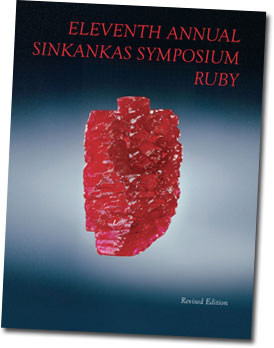 |
| Pala International is pleased to be co-publisher of the revised edition of the proceedings of the Eleventh Annual Sinkankas Symposium – Ruby. This lovely, 130-page volume is now available for online purchase. |
[back to top]
Houston Fine Mineral Show: April 25–27, 2014
Later this month, purveyors and procurers of first-rate mineral specimens will be heading to Houston for the Fine Mineral Show. Pala International’s Will Larson will be in attendance, perusing the booths of nearly fifty dealers. The show is held at the Embassy Suites near The Galleria and features free parking and free admission. If you’re curious about the fluorite specimen used in this year’s publicity, photographed by James Elliot, we obtained the following from the show’s Facebook page: it’s from Southern Illinois, measures about 2.5 inches tall. The black, rectangular forms in the crystal at upper right are actually very dark purple crystal inclusions. The Fine Mineral folks also have announced the new Denver Fine Mineral Show, to be held September 6–9, 2014, at the Denver Marriott West, in Golden. Pala International is pleased to participate in the inaugural show (as well as the Colorado Mineral & Fossil Show, as usual). [back to top] |
Mineral & Gem à Sainte-Marie-aux-Mines: June 26–29, 2014
The 51st Sainte-Marie show will be held June 26–29, with the first two days limited to trade only. This year, Bill, Will, and Carl Larson will attend the show along with friend and fellow gem dealer Mark Kaufman. Details are still forthcoming for the 51st Sainte-Marie show in June, but we thought we’d point to our friend Alain Martaud’s limited-edition book, The Minerals of Sainte-Marie-aux-Mines. Alain discovered the Sainte-Marie mining district at age 14 and over the years has built strong relationships with collectors and museums, allowing the reader to access to a treasure trove of specimens and more. The 208-page book, signed by the author, contains 356 photos of the minerals found in Sainte-Marie’s Val d’Argent in the last millennium. The book also includes illustrations, maps and historic documents. The text is trilingual: French, English and German.
The book is available from the show’s online store. [back to top] |
Pala International NewsPala’s Featured Specimen: Chrysoberyl Twin from BrazilThis month’s featured mineral is a chrysoberyl twin that dates back to the 1970s when they hit one large pocket full of great specimens like this very one. The surface of the crystal has very nice striations and the transparency can be seen in the tips of it. This V-twin chrysoberyl is quite large for the species and is in very good shape with no damage. A prize for any major collector!
Interested? Contact us to inquire. [back to top] |
Excellent Birds: Carvings of the Klein Family of Idar-ObersteinPala International has commissioned a new gem carving collection: hummingbirds. Bill Larson explains… The project came about because of my boys Will and Carl. They asked about the wonderful miniature bird carvings collection we have from Gerhard Becker, from the famous gemstone town of Idar-Oberstein in southwestern Germany. (For an example of Becker’s work, see the tail end of this story.) I was able to tell them that the carvings were designed and created by Gerhardt Becker but were carved by the Klein family. We happen to know the Kleins; these days the next generation of Kleins—Stephan and Gabi—are running the show.
We had many parrots and other birds in our collection, but my sons noted that we only had one hummingbird, and these of course are the favorite of most everyone in California. So it was simply a matter of inviting Stephan over for the 2012 Denver show, via California, where he selected many different colors and pieces of tourmaline rough I still had from the Himalaya Mine as well as several aquamarines from Nigeria. We shipped the material to Idar-Oberstein and reviewed several different design ideas—all by the Kleins and slightly modified by our resident bird expert Gamini Ratnavira, the wonderful wildlife artist from Sri Lanka. Our project had started to take life: the creation of several hummingbirds sculptures on rock crystal orchids. I’m happy to report that after about a year and a half we now have four new and wonderful sculptures that complement, extraordinarily well, the miniature tourmaline bird sculpture collection from 30-plus years before. All this talk about tiny birds reminds us of the hummingbird inclusion enshrined in Harold Van Pelt’s freeform crystal carving, which Pala’s Mia Dixon highlighted three years ago this month. [back to top] |
Minerals and Mineralogy NewsTerra Antiqua: Fire and WaterFarms and ranches and vacant (p)lots have a habit of producing mineral treasures. In 2007, a huge red spinel crystal was stumbled upon in a farmer’s field in Mahenge, Tanzania, causing a commotion. In 2009, a two-inch square emerald was plucked from the ground of a North Carolina farm. In 2012, a Sri Lankan farm was rushed by sapphire seekers. That same year, a farming area in Madagascar had its own rush of corundum hunters. This year, an overlooked plot in Burma’s jade fields bearing what was thought to be a huge boulder of the green stuff turned out to be a false alarm (at least for now). And our featured mineral specimen for October 2011—a Zimbabwean alexandrite sixling—hailed from Girdlestone Farm. (Don’t hit me…)
Now, a Western Australia sheep ranch has yielded what scientists are calling the oldest crystal ever to be verified, placing it at 4.4 billion years old. A zircon crystal collected in the Jack Hills region has been dated due to its “uranium-lead clock,” as reported by BBC on February 24. A study of the crystal, led by John W. Valley of the University of Wisconsin, is published in the journal Nature Geoscience (7, 219–223 [2014]; available here).
Waterborn [sic] diamond leads researchers to… water
A diamond found in river gravels in the farming area of Juína, Mato Grosso, in western Brazil has led scientists to conclude that Earth conceals an “ocean’s worth of water” less than 500 miles below its surface, as described in a Slate report March 16. A $20 diamond specimen, found in 2008, was determined to contain an inclusion of ringwoodite, which contains enough water to make researchers led by Graham Pearson (University of Alberta) confirm theories that water—“bound up in rock,” as described by Slate—lies between the Earth’s upper and lower mantles. The researchers’ study is published in the journal Nature (507, 221–224 [13 Mar 2014]). [back to top] |
Industry NewsA Drought with a Golden LiningCalifornia’s record-setting rainfall lows have benefited one group: the state’s gold prospectors. According to a February 24 story posted by CBS Los Angeles, the severe drought has exposed gold in waterways, allowing access by prospectors who now, the report says, are bringing along their families to aid in the historic quest.
Mine Causes Move—A Whole TownSweden’s northernmost town of Kiruna has its own troubles. A nearby iron mine threatens to swallow the town, just as predicted a decade ago by the state-owned mining company, Luossavaara-Kiirunavaara AB, according to a March 5 story by BBC. Twenty thousand people will be moved two miles away over the next twenty years. A church that was voted the country’s most beautiful building in 2001 will be dismantled and rebuilt. [back to top] |
Pala PresentsGem- and Lithium-Bearing Pegmatites of the Pala DistrictPart 4: Descriptions of Selected MinesWith Pala Presents, we offer selections from the library of Pala International’s Bill Larson, who will share with us some of the wealth of information in the realm of minerals and mineralogy. This study of the pegmatites of the Pala district was conducted in the late 1940s by Richard Jahns and Lauren Wright. A total of 39 weeks of field work was done between the two researchers. The project examined more than 350 pegmatite dikes; four of those were mapped, one of which in detail for more than half a mile of its entire exposed length. Sixteen mines were mapped and a hundred more mines and prospects visited and studied. A monumental undertaking.
The fourth and final part of our offering consists of “Descriptions of Selected Mines.”
In addition to several photographs, maps and diagrams, three detailed plates, such as the one pictured above, are provided for the Tourmaline Queen, the Stewart and the Pala Chief mines. [back to top] |
Recycle BinBelow are recent items from our sibling publication, Palagems Reflective Index, that will be of interest to mineral enthusiasts. Views on TucsonIn our February gem newsletter, we included some candid camera angles from the 60th Annual Tucson Gem and Mineral Show. See “Black Hats: Tucson in Pictures.” In our March newsletter, we pointed to two other, comprehensive collections of Tucson shutter-shots. As she always does, our friend Eloïse Gaillou, curator of the Natural History Museum of Los Angeles, shares her favorite sights from the gem and mineral shows, and Tucson was no exception. Her posts are divided in two—Mineral Shows and Gem Shows—but there is plenty of crossover. Walk in hungry.
We were just informed by Eloïse that the Gem and Mineral Council of the Natural History Museum is offering a tour of Burma in the fall. Details here. [back to top] |
Denver Museum Debuts New Hall, Collection Housing
In our February gem newsletter, we noted a Valentine’s Day opening at the Denver Museum of Nature and Science. Debuting was the museum’s Anschutz Gallery, part of the new 126,000 square foot, five-level, $56.5 million Morgridge Family Exploration Center. In addition to galleries and classrooms, two underground floors—63,000 square feet—are devoted to the Rocky Mountain Science Collections Center, providing consolidated housing for the first time of nearly 1.5 million specimens and artifacts. Also unveiled were two sculptures in the new wing’s Nature Plaza, which is in front of the wing’s entrance. Iridescent Cloud, pictured below, is shimmery and light. “The artists’ concept was inspired by the Museum’s gems and minerals collection, exhibits about the physical properties of light, and Colorado’s dramatic sun and sky,” according to a press release.
Less successful is the companion installation, Spectral Band, composed of an arc-shaped path of lithocrete pavement in colors of the visible spectrum, i.e., a rainbow, ending with—you guessed it—a pot of (fool’s) gold. Whereas Iridescent Cloud transcends the sum of its many parts, Spectral Band is simply dull—a conceptual piece hampered by the limitations of its execution. But then, the pyrite is worth a look.
[back to top] |
February 2014 Newsletter
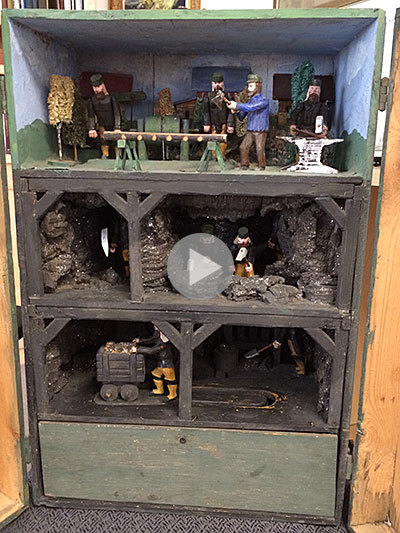 |
| Workin’ it. An animated mine diorama depicting mining activity, Germany, circa 1900. Most of the miners are on-the-job (see video): at top, chopping wood and smithing; in middle, hammering rock; below, pushing the mine trolley and shoveling ore. From the collection of Pala International. (Photo: Bill Larson) |
Shows and Conferences
- Tucson Time
- Twelfth Annual Sinkankas Symposium – Peridot (and more) – April 5, 2014
- 2nd China (Changsha) Mineral & Gem Show: May 15–20, 2014
Pala International News
Mineral and Mineralogy News
Industry News
Pala Presents
Recycle Bin
- John S. White: Reminiscences of a very old Former Curator
- Crystal Gazing
- Vanishing Act in Vancouver
- Fleurs de bon: The Multifaceted World of John Hatleberg
- Ruby & Sapphire: A Collector’s Guide
By Richard W. Hughes with photos by Wimon Manorotkul and E. Billie Hughes
Shows and Conferences
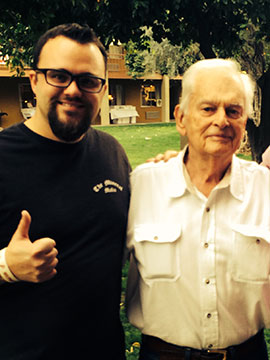 |
| Early birds. Will Larson enjoys the Tucson sun on Saturday with legendary mineral dealer Charles Locke Key, after whom keyite is named. The type locality for this beautiful blue crystalline material is Tsumeb, Namibia, from which a variety of blue/green minerals hail, such as malachite, dioptase, and azurite. (Photo: Bill Larson) |
Tucson Time: February 4–16, 2014
We’re looking forward to the world’s greatest gem and mineral show in February. One-stop general information about individual shows can be obtained from the Tucson EZ-Guide.
Pala International will be represented in Tucson as follows. We look forward to seeing our many friends there. Visit the Pala International Show Schedule for future events.
AGTA GemFair
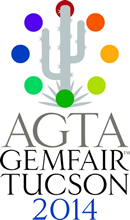 |
Pala joins nearly 100 exhibitors for this trade-only annual extravaganza.
Event: AGTA GemFair
When: February 4–9, 2014
Where: Tucson Convention Center
Pala International Booth: 1016
The event website now features an interactive floorplan allowing you to see who is exhibiting by area of the convention center.
Free seminars by notables in the world of gemstones and pearls are now listed. Special exhibits this year include
- Displays of the Spectrum Awards winners for gem and jewelry design as well as the finalists of the International Pearl Competition
- The “Magical Gifts of Nature” a new traveling exhibition of Extraordinary and Incredible Cultured and Natural Pearls
- Highlights of the Smithsonian Institution’s Janet Annenberg Hooker Hall of Geology, Gems & Minerals
- Somewhere In The Rainbow – A Modern Gem and Jewelry Collection
13th Annual Westward Look Mineral Show
Pala International and two dozen other world-class mineral dealers shack up at a Sonoran Desert resort.
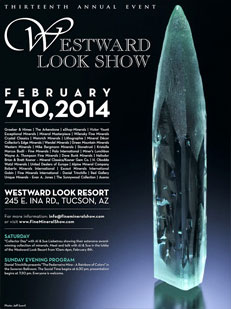 |
- Collector Day (Sat) features Al and Sue Liebetrau and selections from their private collection
- The Pederneira Mine – A Rainbow of Colors (Sun) features Daniel Trinchillo
Event: 12th Annual Westward Look Mineral Show
When: February 7–10, 2014
Where: Westward Look Resort
Pala International Suite: 224, Building 20, Upper Level
See Pala International’s page on the Westward Look Show site. See also this dealer map.
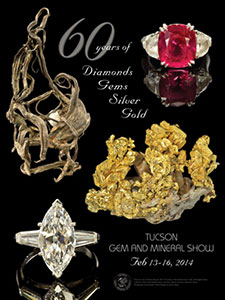 |
60th Annual Tucson Gem and Mineral Show
TGMS is the largest gem and mineral show in the country. This year’s theme is “60 Years of Diamonds, Gems, Silver and Gold.” The Grand Prize drawing, to be held at the show’s end, is white gold and diamond pendant.
Event: 60th Annual Tucson Gem and Mineral Show
When: February 13–16, 2014
Where: Tucson Convention Center
Pala International Booth: Aisle 5 East, #0926–0929
The seminar and lecture lineup is now available here. [back to top]
Pala’s Bill Larson and GIA’s John Koivula to Present at TGMS
Take your Valentine to the ends—and depths—of the earth this year in Tucson.
Bill Larson will discuss “The Gem and Crystal treasures of the mythical Valley of Mogok” on Friday, February 14 in the Crystal Ballroom, 11 a.m. to 12 noon. This talk highlights his 20+ years of traveling to the amazing country of Burma. You won’t want to miss it.
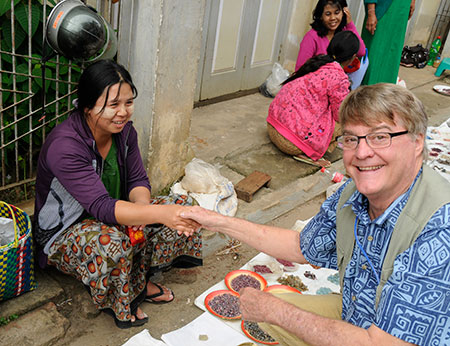 |
| Done deal. Bill Larson shakes hands with a vendor in downtown Mogok, in the fall of 2013—his 34th visit to Burma. (Photo: George Hickox) |
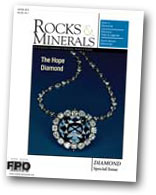 |
John Koivula will present “The Microworld of Diamonds” to the Arthur Roe Memorial Micromount Symposium at 10:40 a.m. on February 14 in the Turquoise Ballroom. This will be a chance for mineral enthusiasts to meet a legend in the field of gemology, with Koivula being world-renowned in the area of inclusions. “Some mineral inclusions are very colorful, some are extremely ancient, some may be very rare, some can affect their host in a disastrous way, and some can be so beautiful that they compel us toward further study,” Koivula stated in a recent press release. “Any inclusion can teach us something about the diamond enclosing it. Diamond’s incredible durability and generally high transparency provide a clear window through the rocky crust and into the earth’s molten interior below the Moho.” As we noted in our sibling publication, Koivula’s “The Microworld of Diamonds: Images from Earth’s Mantle,” coauthored with Elise A. Skalwold, is featured in the Jan–Feb edition of Rocks and Minerals. It will be available at the journal’s TGMS booth, #1219–1221. Koivula will have his book, The MicroWorld of Diamonds, for sale at his Symposium presentation. The symposium (schedule here) is on the Galleria floor of the Tucson Convention Center and does not require purchase of a ticket to attend. [back to top]
Tucson Transit Tips
Many shows will offer their own shuttles. View your transit and parking options here. [back to top]
Twelfth Annual Sinkankas Symposium – Peridot and Uncommon Green-colored Gem Minerals
April 5, 2014, GIA World Headquarters and
The Robert Mouawad Campus, Carlsbad
The annual Sinkankas Symposium has been described by John Koivula as the “best gem mineral symposium in North America” and has a reputation for achieving sold-out enrollment.
This year’s theme focuses on green-colored gems that have lower public recognition than their more illustrious counterparts such as emerald, jade, etc., with peridot perhaps the most well-known. For instance, Pala International’s Bill Larson will offer “Green with Envy,” a photographic odyssey of fine crystals and cut gems from worldwide localities featuring peridot and a panoply of uncommon green gems of beguiling beauty ranging from A (actinolite) to Z (zircon). Lisbet Thoresen, whose study of ancient garnet we reviewed, will discuss the disappearing act of the “poor man’s emerald” in her presentation, “Chromian Chalcedony: A Gem from History’s Lost and Found.”
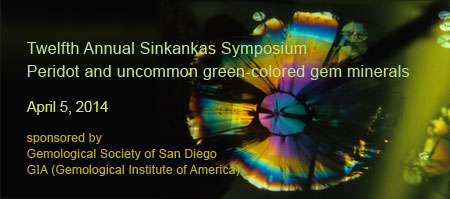 |
Visit the Sinkankas Symposium website for speaker bios and abstracts of presentation topics.
- Dr. Raquel Alonso-Perez
- Dr. James A. Harrell – Archaeogemology of Peridot
- William Larson – Green with Envy
- Shane McClure
- Nathan Renfro – Cutting Peridot and the Exploration of Its Inclusions
- Dr. George Rossman will discuss the causes of color in green gem minerals
- Dr. James Shigley
- Dr. Skip Simmons – Mineralogy and Crystallography of Peridot
- Lisbet Thoresen – Chromian Chalcedony: A Gem from History’s Lost and Found
- Robert Weldon
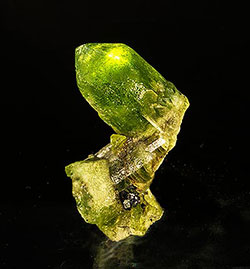 |
| Envious? A beautiful peridot crystal perched on a massive peridot matrix—with a magnetite cluster to boot. Inv. #20962. (Photo: Jason Stephenson) |
The Sinkankas Symposium is organized by Roger Merk, and co-sponsored by the Gemological Society of San Diego and the GIA (Gemological Institute of America). It will be held Saturday, April 5, 2014, at the GIA World Headquarters and The Robert Mouawad Campus, 5345 Armada Drive, Carlsbad, CA 92008.
Registration
The registration form is posted on the Symposium website after past attendees are sent their invitations. Join the San Diego Mineral & Gem Society mailing list to be kept informed; after submitting your email address, be sure to select the Sinkankas Symposium checkbox.
 |
| Pala International is pleased to be co-publisher of the revised edition of the proceedings of the Eleventh Annual Sinkankas Symposium – Ruby. This lovely, 130-page volume will be available at the Pala sites at Tucson beginning on Sunday, Feb. 9. Co-publisher (and symposium organizer) Roger Merk also will have copies (TGMS booth #1620-1622). The proceedings will be made available for online purchase about mid-month; check the Symposium website for news. |
Bill Larson to Address SDMG 80th Annual Banquet
 |
It’s a year of milestones, with the Tucson Gem and Mineral Show celebrating 60 years, and the San Diego Mineral and Gem Society marking its 80th birthday. Pala International’s Bill Larson will be the featured speaker for the latter bash, to be held on Saturday, March 8, 2014, 11:30 a.m., at the 94th Aero Squadron Restaurant, 8885 Balboa Ave., San Diego.
Bill will show highlights from various mines in San Diego County—exceptional specimens that include morganite, kunzite, garnet, and rare gem species. He noted, “I was the speaker at the 70th anniversary, so I guess my goal is to speak at the 100th!”
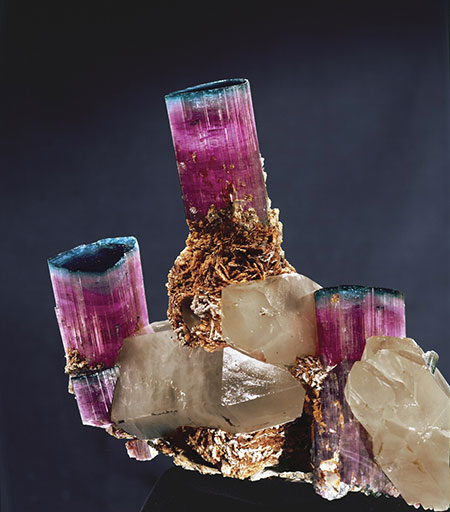 |
| The “Candelabra” Tourmaline was mined in 1972 by Bill Larson at the Tourmaline Queen mine in San Diego County’s Pala District. “What a sight,” he recalled years later, “over a foot long.” (It actually is about a foot and a half.) It now is on public display at the Smithsonian Institution in Washington, DC. (Photo: Harold & Erica Van Pelt) |
Ticket info and more details for the banquet available here. [back to top]
2nd China (Changsha) Mineral & Gem Show: May 15–20, 2014
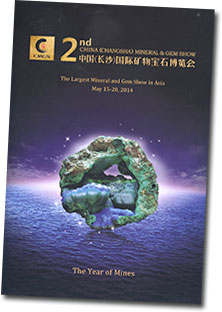 |
| The theme of this year’s show is “Mines.” |
Take a breather after Tucson, buy a new pair of sensible shoes, and take off for the 2nd China (Changsha) Mineral & Gem Show, May 15–20, 2014. With two floors and hundreds of exhibitors, you’ll want to be light on your feet. Trade-only days are May 15 and 16; public days are May 17–20, at the Hunan International Conference & Exhibition Center.
Reports on last year’s show by Pala International’s Will Larson as well as by Dr. Peter Megaw and Allison Megaw noted room for improvement, mainly in timely delivery of international dealers’ shipments through customs. (And the wine list could have been ramped up a notch.)
Last year’s show theme was “Mineral Museums,” and the Megaws wrote that the Chinese government was working on the development of more than a thousand new natural science museums. Four hundred were opened in 2011 alone, according to a show statement. “Not only have the newly opened museums had great procurement demand in mineral and gem collections,” reads the statement, “but also the public.” [back to top]
Pala International News
Pala’s Featured Specimen: Rough & Cut Diopside
On our way out the door and on the road to Tucson, we feature a rare and beautiful green gem. Diopside ranges from brown to yellow to olive green to intense green. This month we feature a couple of stunning cut diopsides from Burma. The larger yellow cushion is 17.45 carats and the smaller green one is 4.90 carats. These gems are paired with an exceptional evergreen crystal from China, measuring 5.5 x 2.5 x 2.5 cm.
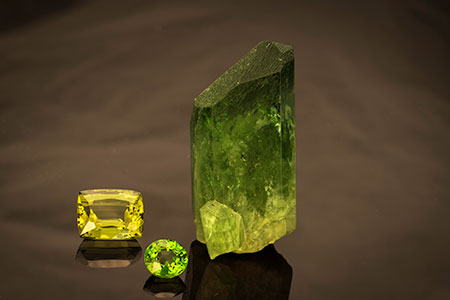 |
| Green jewels from the Larsons’ collection. Click to enlarge. (Photo: Mia Dixon) |
Interested in something along this line? Contact us to inquire. And see us in Tucson. [back to top]
Mineral and Mineralogy News
Like a Rolling Stone: Danish on Mars
No, the Danes have not eclipsed (sorry) the U.S. on a manned expedition to the red planet. We’re talking jelly donut.
NASA’s APOD (Astronomy Picture of the Day) last Wednesday was actually two images: the same patch of Martian surface photographed twelve days (sols) apart. Missing from the earlier photograph, snapped by the robotic rover Opportunity, is what has been referred to as a “jelly donut” due to its appearance. Its materialization may best be explained as having been flicked into the frame by one of the rover’s tires, perhaps upturning what had lain jelly-side down for quite some time. What hasn’t been explained fully is the result of chemical analysis.
At Jet Propulsion Laboratory’s public ten-year celebration of the Mars Exploration Rovers, mission principal investigator Steve Squyres remarked,
We got our first data on the composition of the ‘jelly’ [portion of the rock] yesterday, and it’s like nothing we’ve ever seen before. It’s very high in sulfur, it’s very high in magnesium, it’s got twice as much manganese as we’ve ever seen in anything on Mars. I don’t know what any of this means. We’re completely confused. We’re having a wonderful time. Everybody on the team is arguing and fighting. [The relevant segment of Squyres’s talk begins at 25:08.]
But one other earthling was having none of it. As reported on January 28 by Popular Science, “self-described scientist” Rhawn Gabriel Joseph filed a lawsuit the day before in U.S. District Court demanding that NASA come clean, admitting that the Danish really is a fungus. In an online article dated January 27, Joseph claims that “a small ‘bowl-shaped’ growth” appears in both images below (note that the originals were in black and white). It just mushroomed (sorry) in twelve days, exactly, Joseph avers, as would an apothecium, the cup-shaped fruit of certain fungi and lichens. Joseph did do some good cherry-picking, finding a taste-tempting image of several apothecia that might have come from the same pink box as the one on Mars.
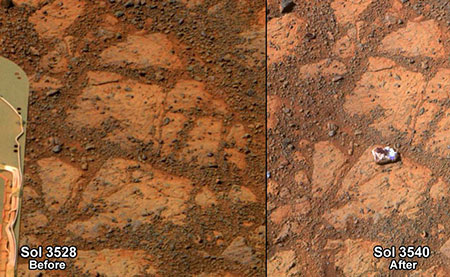 |
| I’ll take a dozen. Left, sol (Martian day) 3,528 of the Opportunity rover’s work on mars, Dec. 26, 2013; right, twelve days later, Jan. 8, 2014. (Photo: Mars Exploration Rover Mission, Cornell, JPL, NASA) |
Adding to the mystery, the rover team named—code named, per one report—the jelly donut “Pinnacle Island,” also a name for the Senkaku archipelago whose sovereignty is being disputed by China, Taiwan, and Japan. A key may be the rock’s location—on the Murray Ridge section of the Endeavour Crater rim. Perhaps the greatest mystery is how, in this day when government supposedly can do no right, the anticipated three-month mission of Opportunity, like the Energizer Bunny, keeps going and going. [back to top]
Getting Deep in Stockholm
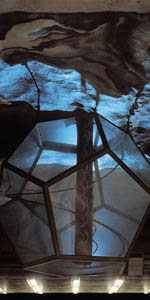 |
We’ve all driven through them: tunnels with bare rock covered by a icing of sprayed concrete, leaving a bland lumpy surface. But what if that surface were seen as a blank canvas, as the plaster of a fresco? The city of Stockholm, Sweden has commissioned artists to do just that since its 100-station metro system opened in 1950, with stunning results captured by photographer Alexander Dragunov. The photographer has self-published a book of his images, entitled, simply, Tunnelbana, Swedish for “subway.” The images are pristine and remarkably free of travelers (and trains).
At e-press time we hadn’t received reprint permission, but Dragunov’s images are all over the Web. To get a quick taste, view this brief streaming video.
The thumbnail image above, taken from the metro’s website, is what a rider would see at the University of Technology station. Artist Lennart Dark’s background in set design is evident in the dramatic delivery of the pictured twelve-faced dodecahedron, one of five displayed “noble” polyhedra (isohedral and isogonal; equal-faced, equal-angled). The polyhedra are related to the so-called Platonic solids conceived of as the building blocks of classical elements, i.e., fire ≈ tetrahedron, earth ≈ cube, air ≈ octahedron, water ≈ icosahedron. The fifth Platonic solid (and “noble” polyhedron) is the dodecahedron, an ethereal element related to the god who is artist of the cosmos.
“Among all technical and mathematical symbols,” the metro website explains, “we find illustrations and quotes by famous scientists and philosophers such as Plato, Descartes, Leonardo da Vinci, Copernicus, [Swedish scientist Christopher] Polhem, Einstein and others.” A little something deep to ponder while waiting on the next train. [back to top]
Industry News
BlueCap in Burma
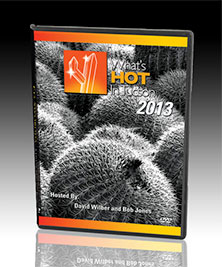 |
| Missed last year’s show? Check out the trailer for What’s Hot In Tucson, which is available on DVD or streaming HD. Friends of Pala International get a 10% discount on any BlueCap order. Just enter the code palaintl when you’re asked for it while ordering. |
BlueCap Productions’ Bryan Swoboda has followed in the footsteps of his late father, Ed Swoboda, by traveling to Burma—camera in hand. As Bryan noted in a recent e-blast, “When I think of Burma, I always remember stories from my father’s 1955 trip to Burma and how photos from that trip ended up in Pete Bancroft’s seminal and classic book, Gem and Crystal Treasures.”
Bryan spent two weeks in Burma last fall, even missing Thanksgiving in his new Honolulu home with his wife and children. Mogok: The Legendary Valley of Rubies is the result of the visit and a trailer for the film will debut at the Pueblo Gem & Mineral Show, in Tucson, on Monday, February 10, after Federico Barlocher’s 7:00 p.m. presentation on Mogok. The trailer also will be screened at TGMS, at the booth BlueCap shares with Mineralogical Record (#1326-1328A). [back to top]
Pala Presents
Gem- and Lithium-Bearing Pegmatites of the Pala District
Part 3: Economic Features of the Pegmatite Minerals; Mining
With Pala Presents, we offer selections from the library of Pala International’s Bill Larson, who will share with us some of the wealth of information in the realm of minerals and mineralogy.
This study of the pegmatites of the Pala district was conducted in the late 1940s by Richard Jahns and Lauren Wright. A total of 39 weeks of field work was done between the two researchers. The project examined more than 350 pegmatite dikes; four of those were mapped, one of which in detail for more than half a mile of its entire exposed length. Sixteen mines were mapped and a hundred more mines and prospects visited and studied. A monumental undertaking.
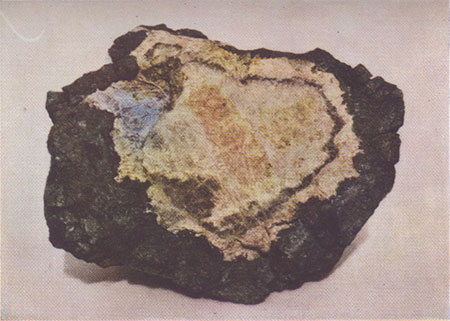 |
| Crystal of Lithiophilite. With alteration products, Stewart Mine. Pale tan to flesh-colored lithiophilite is rimmed successively by flesh-colored hureaulite, deep reddish-brown sicklerite, buff to pale tan salmonsite, and salmonsite and other phosphate minerals stained with manganese oxides. In addition there are numerous crystalline aggregates of blue strengnite, purplish purpurite, ad canary-yellow stewartite. A thin veinlet of hureaulite (palaite) and stewartite cuts diagonally across the specimen, which is 5½ inches long. Earl Calvert collection. |
Part three of our offering consists of two sections. In “Economic Features of the Pegmatite Minerals,” the following major topics are covered.
- Lithium minerals
- Feldspars
- Gem minerals
“Mining” discusses these major topics:
- Prospecting and mining methods
- Production
- Future possibilities
The text of these sections is interspersed with 17 color plates—both photographs and detailed illustrations—of gem mineral crystals, specimens, location views, as well as faceted and cabochon-cut gemstones.
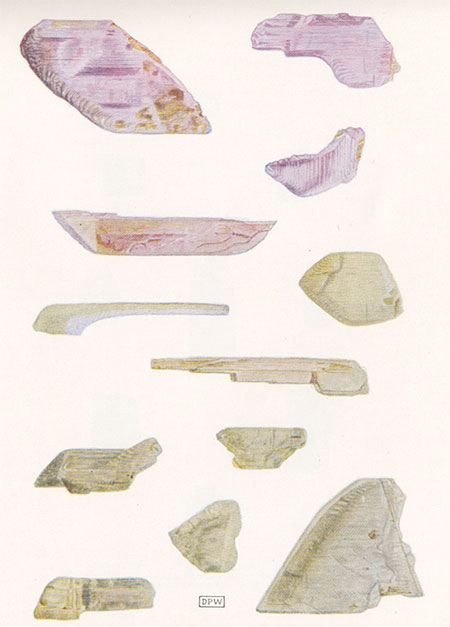 |
| Crystal fragments of gem spodumene. Pala Chief mine. Pink to lilac—kunzite; colorless to yellow—triphane; green—hiddenite. |
[back to top]
Recycle Bin
Below we offer mineralogically oriented items from the last two editions of our sibling e-publication, Palagems Reflective Index.
John S. White: Reminiscences of a very old Former Curator
Last spring, John S. White delivered a presentation to the 40th Rochester Mineralogical Symposium (RMS) under the title, “Reminiscences of a very old Former Curator.” Yes, it was going to be that kind of a talk—filled with the recollections that might be inapt for, shall we say, less pliant, occasions. That’s not to say that this talk didn’t reflect the earnest passion with which White approached his career. But with this presentation, what might never have seen the light of screen was retrieved from the digital dustbin to provide a different slant on a curriculum vitae that includes, among a host of highlights, time working at the Smithsonian with his mentor Paul E. Desautels, “the most influential American curator of the 20th century” by The Mineralogical Record, itself an influential journal that White founded in 1970.
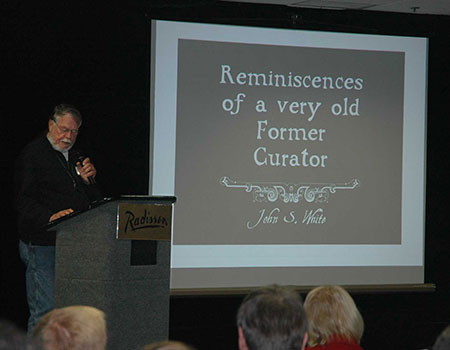 |
| John S. White, speaking at the 40th Rochester Mineralogical Symposium in 2013. (Photo: Elise Skalwold) |
In his RMS presentation, now posted with permission on YouTube, White takes us through his early life, beginning with a fortunate and providential meeting with Desautels. White would be hired by the Smithsonian years later, and in his talk he tours us on the inner workings of the Mineral Sciences Department, displaying a list of the institution’s individual collections, as of the mid 1980s, including that of Nobel-winner Carl Bosch: 25,000+ minerals, 3,000 gems and 600 meteorites. On to a five-week European trip in 1967 with world-class dealer Martin Ehrmann. We’re taken into the Smithsonian’s (non-public) Blue Room and the main hall prior to its renovation.
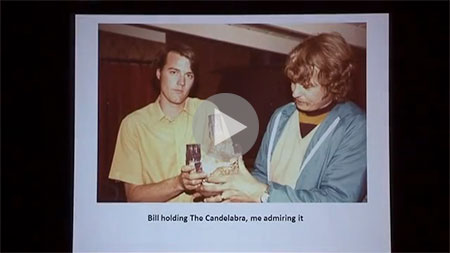 |
| Final payoff. John S. White, right, with Pala International’s Bill Larson just after the discovery of the famous blue-cap tourmalines. In his talk, John tells that during this visit Bill gave him a six-inch blue-cap crystal on a time-payment plan. Years later, after John sold his collection, the crystal “disappeared,” only to be sold a few years ago for nearly three hundred times the original price of $500. When Bill viewed John’s talk, he recalled the crystal passing through the hands of David Eidahl and Louis Schwartz, then “in the late 1980s back to me at $5000. Then, yes, it was sold for $140,000 through Pala International—25 years later.” (Image from John White’s presentation, posted on the PalaInternational Channel at YouTube by permission of John White and the Rochester Mineralogical Symposium) |
As White takes us through his career (in retirement he remains active as a writer, field collector, and consultant) there are several surprises (defying the curse of the Hope Diamond…), as well as a lot of lovely gemstones and mineral specimens. See for yourself here. [back to top]
Crystal Gazing
The International Year of Crystallography brings with it a few other shards worth sharing…
2014 International Year of Crystallography
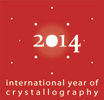 |
The International Year of Crystallography (IYCr2014) is a testament to the importance of crystallography in our lives. For gemologists, that’s a given. But the organizers explain that crystallography has a “fundamental role for the development of the different branches of science: chemistry, mineralogy, physics, biology, medicine, materials science, cultural heritage, geoscience” and more, and that crystallography has a “pervasive presence in everyday life.”
To bring these points home—or abroad—, educational exhibits will travel to Africa, Asia and Latin America. Each region will have a hub from which the exhibition will travel to universities together with instructors. About a dozen activities are included in the exhibition. Other events are scheduled around the world (list-able by country, date and category). There’s a slew of virtual learning opportunities, including visual information and exhibitions, audio and video clips, games, computer applications, and more.
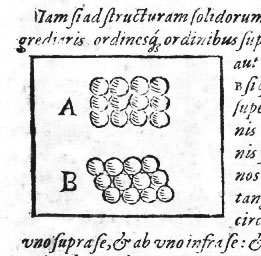 |
| Stacked; packed. This figure from Kepler’s treatise illustrates his postulate on packing. It is included in Wikipedia’s entry on X-ray crystallography. |
IYCr2014 also is a commemoration of two events. First, Johannes Kepler’s De nive sexangula (On the Six-Cornered Snowflake, 1611), written with a “playful and probing” spirit, as characterized by Paul Dry, publisher of a new translation. In late 1610, as he walked across Prague’s Charles Bridge, Kepler took note of the six-rayed, six-cornered nature of snowflakes. London-based writer Philip Ball, in a December 2011 essay regarding Kepler’s brief, 24-page treatise, stated that “[t]his charming, witty work seeded the notion from which all of crystallography blossomed: that the geometric shapes of crystals can be explained in terms of the packing of their constituent particles.” Yet it wasn’t until 1998 that (what’s now known as) the “Kepler conjecture” regarding that packing—i.e., hexagonal packing offers the tightest arrangement—was proven. Ball also notes that René Just Haüy benefited from Kepler’s thinking; so the father of modern crystallography seems to have had a stepfather.
The second IYCr2014 commemoration regards the hundredth anniversary of X-ray diffraction, a method for detailed crystallographic study. Building upon the work of Max von Laue (who had discussed the challenge with Paul Peter Ewald), father-and-son physicists William Henry and William Lawrence Bragg theorized and then proved, via X-ray spectrometry, that crystalline material could be identified due to fingerprinting at the atomic level.
Virtual Museums Offer Educational, Eye Candy
The Virtual Museum of the History of Mineralogy is one of a few dozen resources included in the IYCr2014 educational page. The museum is always worth a browse or two. To find what’s new, read the December 2013 newsletter.
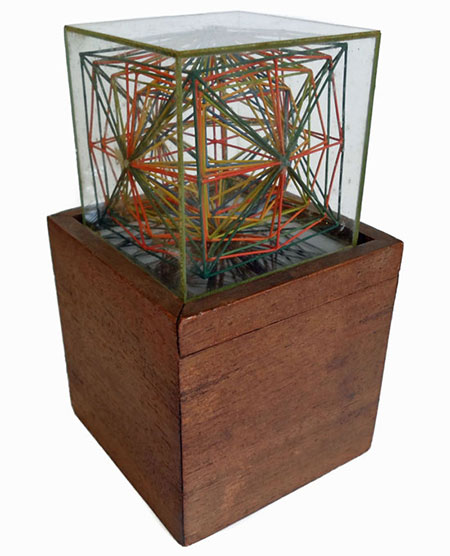 |
| Glass and wire model, 19th century, maker unknown. Glass cube, edge 66 mm. Inside the cube, 9 cubic crystal forms delineated by colored wires are present; three 6-faced, five 24-faced and one 48-faced models. The model comes in a red plush lined mahogany case. From The Tricottet Collection, courtesy of A. Mignan. |
One new item, pictured above, comes to the museum via The Tricottet Collection, which features yet another virtual repository of objects of interest. The Virtual Museum’s Paul Tambuyser told us that the wire model would have been used “to compare different cubic crystal forms and their relation to one another.”
Established in 2006 by Dr. Arnaud Mignan, grandson of Guy Tricottet (1926–1993), The Tricottet Collection aims to preserve items of historic natural history [sic]. The collections consist of three halls—Minerals, Life and Meteorites; special stand-alone collections; libraries, including a library of meteorites; archives, including biographies, labels, manuscripts & correspondence and images; and the cabinet of curiosities. Regarding this last component, in his essay on Kepler (cited above), Philip Ball credits these cabinets (Wunderkammern), or in particular one of the many owned by Holy Roman Emperor Rudolf II (1552–1612), with holding a dodecahedron that might have inspired Kepler in his work on crystals. (These cabinets were, loosely, the antecedents of museums. Visitors to Los Angeles can take in a museum itself devoted to such curiosities, the naughtily named Museum of Jurassic Technology, about which Lawrence Weschler penned Mr. Wilson’s Cabinet of Wonder.)
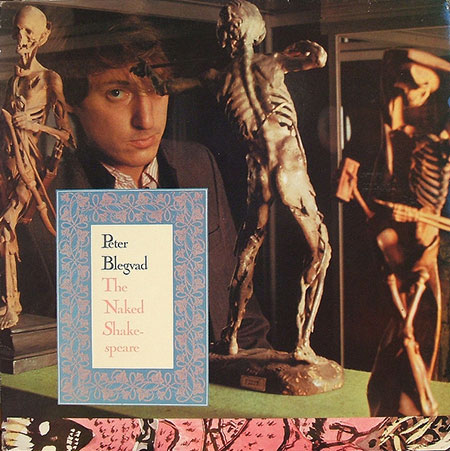 |
| American musician Peter Blegvad, raised in Connecticut and England, stands beside a cabinet of wonder in the cover photo for The Naked Shakespeare, his first solo LP, released thirty years ago last October. Blegvad for a time worked with the band Henry Cow, which in 2009 released a 40th anniversary box set, buyers of which were given a bonus CD, A Cow Cabinet of Curiosities, featuring Blegvad on one track. |
Crystal Gold Mine
We thought we’d toss this in for fun. C-SPAN and mine owner Ray Cropp take you through the day of a hard rock miner—in twelve minutes.
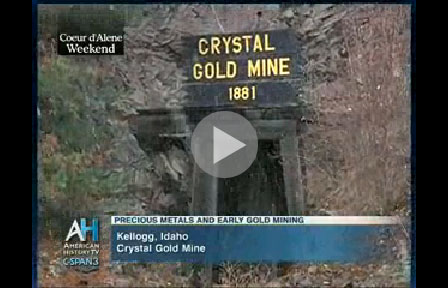 |
Jeepers Creepers
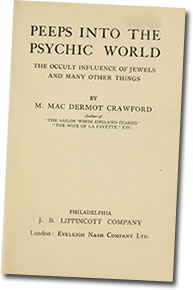 |
“The superstition that certain jewels attract misfortune to their owners is so rarely questioned that it has become an accepted belief….” With this, San Francisco Bay Area-bred expatriate author Mary MacDermot Crawford begins her book Peeps Into the Psychic World: The Occult Influence of Jewels and Many Other Things, published nearly one hundred years ago (available here). Whereas Crawford was the biographer of American naval hero John Paul Jones (1913) and of Adrienne de La Fayette (1907, 1908), wife of the American Revolutionary War general, in 1915 she turned her gaze to the psychic realm. Unconvincingly, she begins the book (only the first 45 pages of which really deal with the subject of its title) by turning to fiction, in the case of opal, to which the “taint of ill-luck clings,” by synopsizing Sir Walter Scott’s Anne of Geierstein, in which Hermione the Persian is rendered “a little heap of ashes” after a drop of holy water meets the “superb” opal of her hair clasp. Crawford then recounts how opal was prized in classical times, and how Queen Victoria gave these stones as wedding presents. Even the opals in Crawford’s collection had, “as yet, brought nothing but good luck. However….” And on and on. Worth a gander into the thinking of one post-Victorian mind and the sort of stuff being written not long before Hermann Hesse, in his own novel The Glass Bead Game, would label our era of attention-deficits the Age of the Feuilleton (i.e., the magazine).
Thumbnail Specimens
Finally, we return to Kepler’s snowflakes, but what he viewed with the nearly-naked eye now is being captured by photographer Alexey Kljatov for our delight. Kljatov, a Muscovite who goes by the handle ChaoticMind75 on Flickr, uses a super-macro camera setup (technique explained and illustrated here).
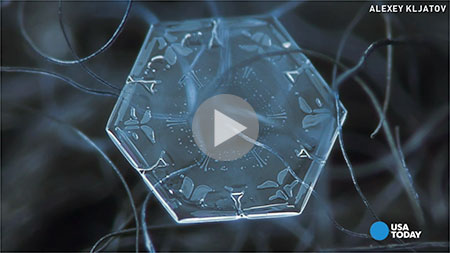 |
Kljatov is not alone in his pursuits. He credits Wilson Bentley with being a pioneer of snowflake photography. And he points to Ontario-based photographer Don Komarechka, author of the newly published Sky Crystals, perfect for Valentine’s Day gift-giving. In his blog, Komarechka began on December 1 to post a flake a day. Our favorite is Day #4: a split-plate crystal that forms from a column-type. [back to top]
Vanishing Act in Vancouver
National Treasure Grabbed in Gastown
The Canadian Press likened the loss to that of the Hope Diamond. Rocks & Gems Canada, a business in Vancouver’s historic Gastown district (named after the area’s first saloon owner “Gassy” Jack Deighton), had its front window smashed early December 20 and a thief stole a large ammolite specimen, Alberta’s official provincial gemstone. Not only is ammolite revered, but it is protected; the Canadian government must approve its removal from the country.
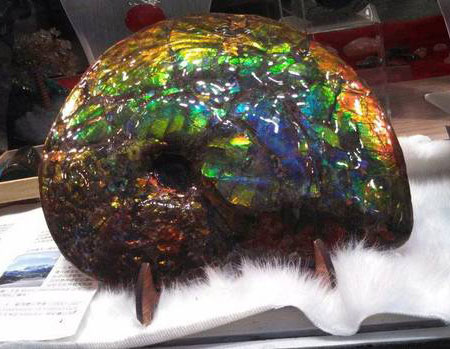 |
| On the lam. Worth about a half a million dollars, this ammolite, stolen on December 20, is considered a national treasure. It is the same material used in jewelry currently on display at GIA, as we reported in December. (Handout photo released on Dec. 23, 2013) |
The shoe-sized specimen measures almost 11 inches. Visible during the day, the store’s window was masked at night, and although protected by bars, the specimen apparently squeezed through. The specimen was from southern Alberta and should be easy to spot at Tucson…
Oh, and by the way, according to Toronto’s Globe and Mail, the Smithsonian Institution owns the Hope Diamond and it is not for sale, in case your Valentine was lacking in bling. [back to top]
Fleurs de bon: The Multifaceted World of John Hatleberg
Since 1987, John Hatleberg has created exact replicas and molds (or both) of the world’s most famous diamonds, including the Hope and the Koh-i-Noor, for the jewels’ owners or guardians, exclusively. Motives behind a replica might vary, but reproductions and even models can be of great significance.
Such was the case with the Koh-i-Noor, once considered the largest diamond in the world. Upon reading about the stone in Ian Balfour’s Famous Diamonds (originally published in 1987; now in its fifth edition), Hatleberg was intrigued to see mention of a model of the Koh-i-Noor, made in the spring of 1851 before its recutting, the model having been commissioned by the directors of the British Museum. (Imagine a master sculptor learning by chance of, say, a replica of the Venus de Milo, tucked away in a Greek archive, complete with arms and plinth.) Hatleberg was impelled to meet with Peter Tandy, earth sciences curator of the Natural History Museum, London, in 1992 to see if the model still existed. What they found was precious—in both senses of the word: a glass-covered box inscribed “Do Not Touch.” It contained a plaster cast of the Koh-i-Noor, and yes, as it was before it was recut. Consequently, Hatleberg was authorized to make new casts of the original fragile cast (and its two pendant diamonds) to preserve what might have perished had the box’s admonition been ignored. It would be thirteen years of research and requests for permission before Hatleberg was allowed to do what he does best: to fashion a replica of the Koh-i-Noor for the museum’s Diamonds exhibition in 2005, a process that took six months. (The full story and its implications are told on JohnHatleberg.com.)
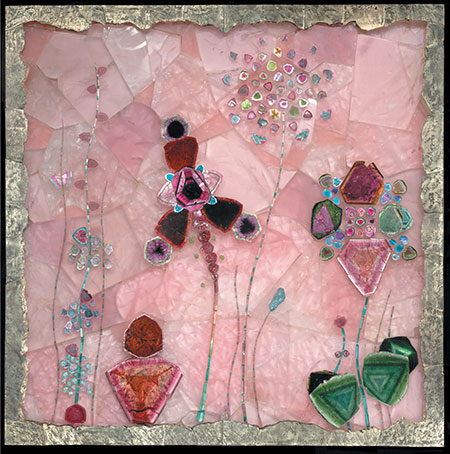 |
| Flower Painting by John Hatleberg, 24¾ x 24¾". Tourmaline, peridot and quartz on a rose quartz canvas in a gilded pyrite frame. Click to enlarge. (Photo: Tony Pettinato) |
On January 3 of this year, Public Radio International (PRI) profiled John Hatleberg, beginning with an image (ahem; the image does accompany the audio) that may be familiar to our readers: the Hope Diamond glowing like the eye of Luis Jimenez’s famous Mustang at DIA. The PRI segment is a personal portrait (as personal as you can get in the space of about 6 minutes), taking you from his studio to his secret vault, and leaving you lusting for more. Well, more might come by way of the fact that Hatleberg is a fine visual artist as well as an exquisite craftsman. His work is quite varied, from a meteorite mirror to a model adorned with 30,000 gems to the whimiscality of a Hope Diamond chocolate and the crazy-quilt expressionism of his own Green Lantern ring.
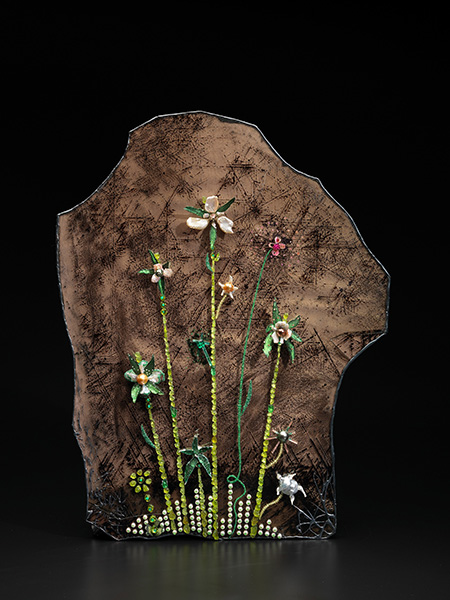 |
| Flower Painting by John Hatleberg, 20 x 15½". Akoya, South Sea, Tahitian, Chinese freshwater, keshi, seed pearls, moldavite, peridot, tsavorite, sphene, fuchsite, lemon quartz, tourmaline, white, yellow, brown diamonds with mica canvas in a patinated silver frame. Click to enlarge. (Photo: John Bigelow Taylor) |
Hatleberg was kind enough to grace us with three images of these other creations. We’re sure you’ll still be left lusting for more…
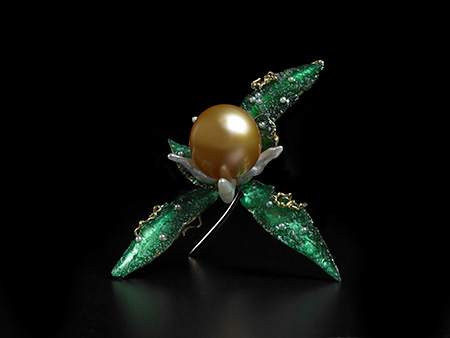 |
| Pin by John Hatleberg. Moldavite and Tahitian, keshi and seed pearls with 18 kt yellow gold. This pin was the inspiration for the flower painting on mica, above. Click to enlarge—please. (Photo: Tony Pettinato) |
[back to top]
Ruby & Sapphire: A Collector’s Guide
By Richard W. Hughes with photos
by
Wimon Manorotkul and E. Billie Hughes
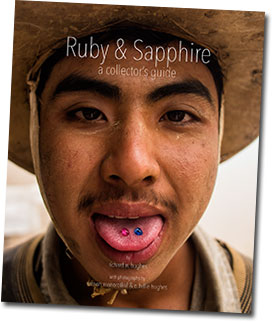 |
In the market for a monograph that is technical enough for the advanced reader but accessible enough for the novice? Such a volume is Richard W. Hughes’s new Ruby & Sapphire: A Collector’s Guide, which will be hitting the shelves of AGTA GemFair tomorrow. Being the brother of the author, your editor had the opportunity to read (and proof) a near-final draft of the book last fall.
As expressed by the title, this book is aimed at the connoisseur, the person building a collection. And because all collections must begin at naught, Hughes points to localities like Australia that might offer the beginner a bargain. But price can deceive and so, via this book, the buyer is armed with a forensics in gemology that balances science against aesthetics (after having received some history and lore, as well as the rules of the road). This is the most technical information, but it is presented cleanly, with lots of space (as is the book’s entire layout); inviting, not daunting.
Closest to Hughes’s heart is Thailand, where he makes his home, and he devotes a 26-page chapter to the country whose ruby and sapphire production has gone from boom to bust during his 30some-year career, while the country remains at the epicenter of the colored gemstone trade.
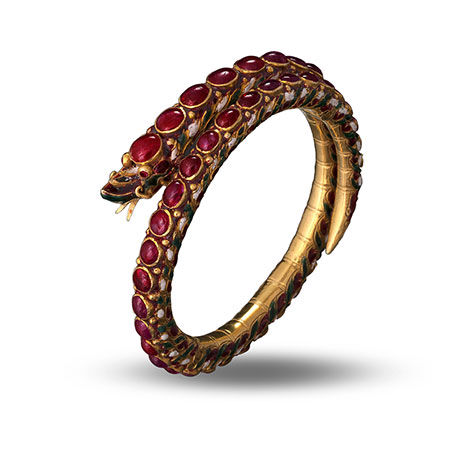 |
| Naga bangle with rubies. Nagas are serpent deities that appear in Thai folklore and Buddhist imagery. Manus Siripatvanich/House of Goldsmiths Collection. Thailand, circa early 1900s. (Photo: Wimon Manorotkul) |
As I noted to my brother while reading the book, one of its nice aspects is that it includes some of the more obscure localities of Africa. When one thinks of Rwanda initially, the Tutsi genocide may come to mind, but this tiny country’s tea plantations are home to sapphire deposits that mostly are hand-worked. Mention Kenya, and tsavorite comes to mind, but Kenyan localities also produce the rare facetable ruby, along with many more cabochon-grade stones. I may be stretching things a bit, but as I was wandering the world through Ruby & Sapphire’s pages, I was reminded of theatre and film director Peter Brook who wasn’t content to work only in the great theaters and opera houses of London and Stratford-upon-Avon. Assembling a polynational company in 1970, and in the face of illness and personal challenges, his International Centre for Theatre Research traveled in Iran and north-central Africa, playing on carpeted dirt instead of stage boards in search of another way of approaching art and relationships. In what I have seen of my brother’s oral and print presentations, he too has sought alternative approaches to science and narrative. And if Brook and crew were ambassadors of their craft, Hughes and his fellows, in their pursuits, are ambassadors in their own right.
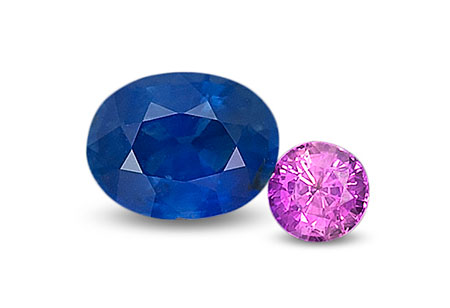 |
| Rwanda sapphires, 1.32 and 0.64 ct; unheated. RWH Collection. (Photo: Wimon Manorotkul) |
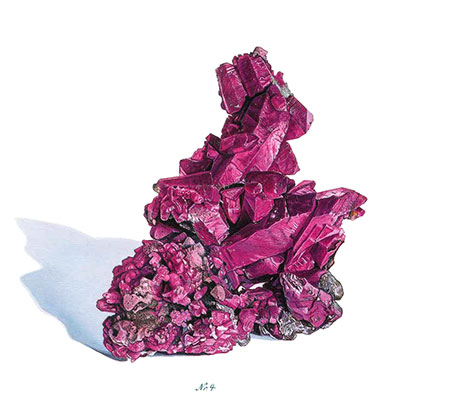 |
| Complex group of intergrown rubies from Luc Yen, Vietnam, painted in 2002 by master mineral artist Eberhard Equit. (Pala International) |
As the author of Ruby & Sapphire wanders the byways, the book’s eye itself wanders away from the gemstones, and we can’t complain when treated to these documents of the varieties of human experience, together with compelling images of flora and fauna (as well as terra), all via the viewfinders of Hughes along with his wife Wimon Manorotkul (her opening photos leap from the page: a Glenn Lehrer sapphire carving, a Burmese bearing gifts) and daughter Billie (whose image of Winza miner Obama is a cultural mashup).
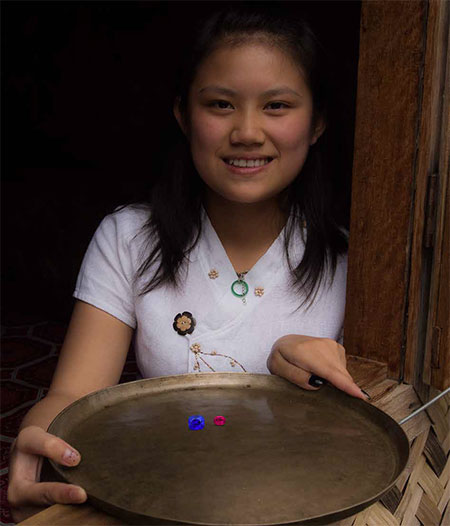 |
| Got the goods. Ma Sandi Maung, above, at Bawpadan in Myanmar’s Mogok Stone Tract, 2013. (Photo: Wimon Manorotkul) A miner named Obama, below, sorts ruby outside his hut at Winza, Tanzania, 2013. (Photo: E. Billie Hughes) |
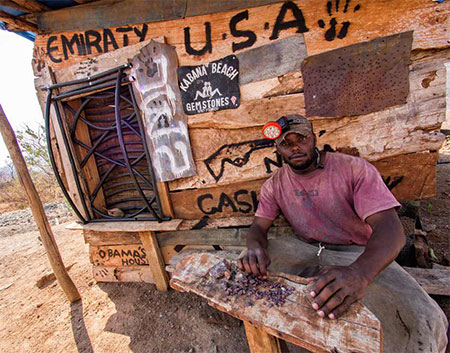 |
And then there are the jewels. My favorites include a Cartier pendant brooch sporting a 28.7-carat diamond-shaped sapphire cabochon from Sri Lanka that, in 1912, reflected the remarkable cross-pollination of Paris, taking its inspiration from Diaghilev’s then-new company, Les Ballets Russes. Also from Sri Lanka is a gorgeous ring, sold by Christie’s in 2005, featuring a 20.84-carat padparadscha sapphire epitomizing the variety’s ethereal lotus-meets-sunset hues. (Hughes, you may recall put this very gemstone up against a strict color-wise definition of padparadscha: it failed.)
Before closing with a visual index of the jewels we’ve lingered over in its pages, Ruby & Sapphire includes an extensive bibliography, an adjunct to the references that are peppered through each chapter.
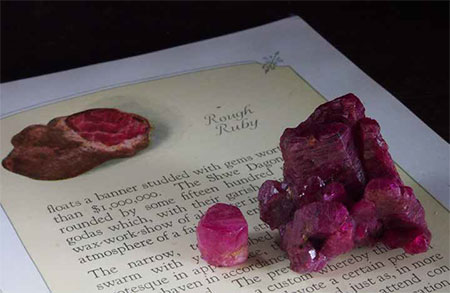 |
| Rough rubies sitting atop a leaf from Albert Ramsay’s rare 1925 book, In Search of the Precious Stone. See our facsimile of this book, a Pala Presents feature on our sibling website, Palagems.com. (Photo: Wimon Manorotkul) |
Look for Ruby & Sapphire at booth No. 38, ground level, at the AGTA GemFair, February 4–9, 2014, Tucson Convention Center. Also at the GemFair, author Richard Hughes will offer a presentation on the same subject as the book: “Ruby & Sapphire: A Collector’s Guide.” The presentation will be held Thursday, February 6, 1–2 pm, Mohave Room.
Your Guides within the Collector’s Guide
Included in Ruby & Sapphire are two “Collector’s Guide” essays, by Bill Larson (“The Connoisseurship of Crystals”) and Paula Crevoshay (“The Tao of Jewelry”), which readers will enjoy.
Pala International’s Bill Larson discusses the fact that, collectible as they are, few great ruby specimens actually exist, in part because so many of the finest have been cut into faceted gemstones. As a consequence of this rarity, he says, many museums do not own a fine specimen to exhibit, a fact that collectors should keep in mind when doing their legacy planning. Read the entire essay here.
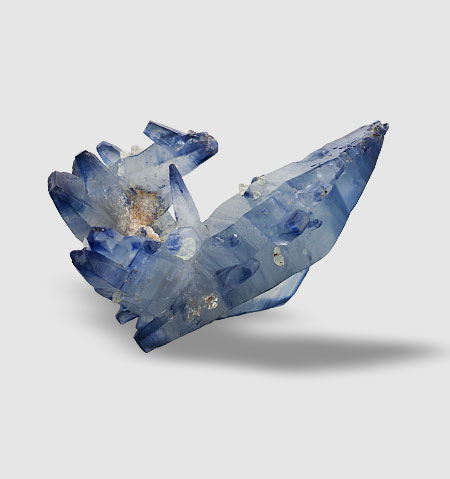 |
| The beauty of nature is revealed through this complex twinned sapphire crystal from Sri Lanka. 88.8 ct. This fine specimen was featured in the Summer 2013 edition of WSJ.Money. It now is in the collection of Beirut’s Museum of Minerals. (Photo: Wimon Manorotkul) |
Paula Crevoshay is a designer of one-of-a-kind jewelry creations that most recently were exhibited at Pittsburgh’s Carnegie Museum of Natural History. Garden of Light: Works by Paula Crevoshay, which was held appropriately during this past spring and summer, featured over 60 of her pieces, taking their inspiration from nature’s bounty and beauty. The jewels were juxtaposed with mineral and insect specimens from the Carnegie’s collection.
Later this month, visitors to the Orlando Museum of Art will have their own chance to experience a Crevoshay conjunction, on a scaled-down scale. As part of the museum’s 90th anniversary celebration, about fifteen Crevoshay nature-themed creations will be displayed, their backdrop being the floral still-life paintings from the seventeenth century’s Golden Age of Painting. The display is part of an exhibition that runs through May 25: Rembrandt, Rubens, Gainsborough and the Golden Age of Painting in Europe from the Speed Art Museum, Louisville, Kentucky.
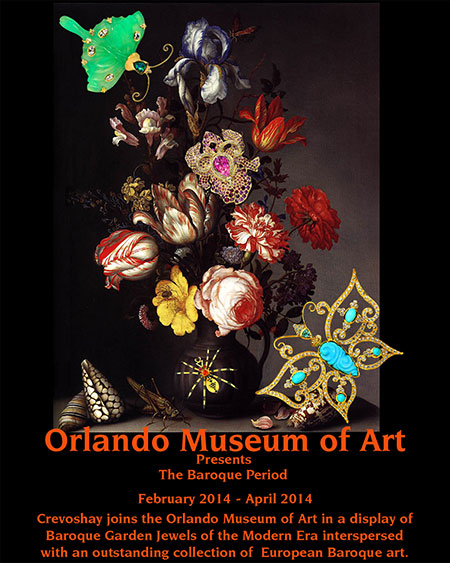 |
| Go for Baroque. As the Orlando Museum of Art celebrates its 90th year with an exhibition of Baroque masterpieces (such as that of Balthasar van der Ast, above), a complementary display will feature about fifteen latter-day nature-themed Crevoshay jewels on loan from at least five local collectors. One more, a butterfly pendant valued at $19,000, can be acquired by the lucky donor who obtains a $25 chance to win, with the proceeds benefiting the museum’s educational programs. The drawing for the pendant will take place in May. |
“The masters of the day,” Crevoshay told us, “include, Willem van de Velde, Rembrandt van Rijn, Hendrick van Somer, Jan van den Hecke the Elder, Jacob Van Walscapelle and many more.” In conjunction with the exhibition, Crevoshay will present a lecture “on the similarities found in the building blocks of the Baroque Period to what built the ‘Nouveau Baroque Period’ of our Modern times,” she said. And she was kind enough to provide us with a thumbnail sketch of the lecture’s details.
During the 1600–1725-plus years there were several major events that radically changed art. First, the religious asylum granted the Protestants from their Catholic countries, which only allowed devotional art; then international trade, which brought in all types of exotic plants, new tools for lapidary, new gemstone materials, and all sorts of commodities; and lastly the major scientific innovations forged during this great time of freedom of expression. This impetus formed a middle class, erected retail establishments, and created retail stores replacing the independent jewelers. Even the discipline of Botany was created during this time due to the many exotic plants coming in through international trade.
In our times we have had similar happenings, creating a surge in excesses in expression in art, science, fashion and consumption starting with civil rights movements that paved the way for the über-wealthy black population to express themselves in all areas previously unavailable to them; the World Wide Web connecting all cultures and topics for a rapid synthesis and growth in all of the arts, sciences and trade; and Hollywood creating a global platform for social fashion expressions, to name a few. The economy and the freedom of expression coupled with innovation has spawned a similar explosion of abundance and excess. Just like King Louis the XIV, men are wearing more jewelry than ever…
Such musing also are reflected in Crevoshay’s Ruby & Sapphire essay, “The Tao of Jewelry,” in which she explains the principles she looks for in fine jewelry—personal ABCs that can aid the serious collector: Art, Bold, Creativity, Detail, and Excellence. [back to top]
— End February Newsletter • Published 2/3/14 —
